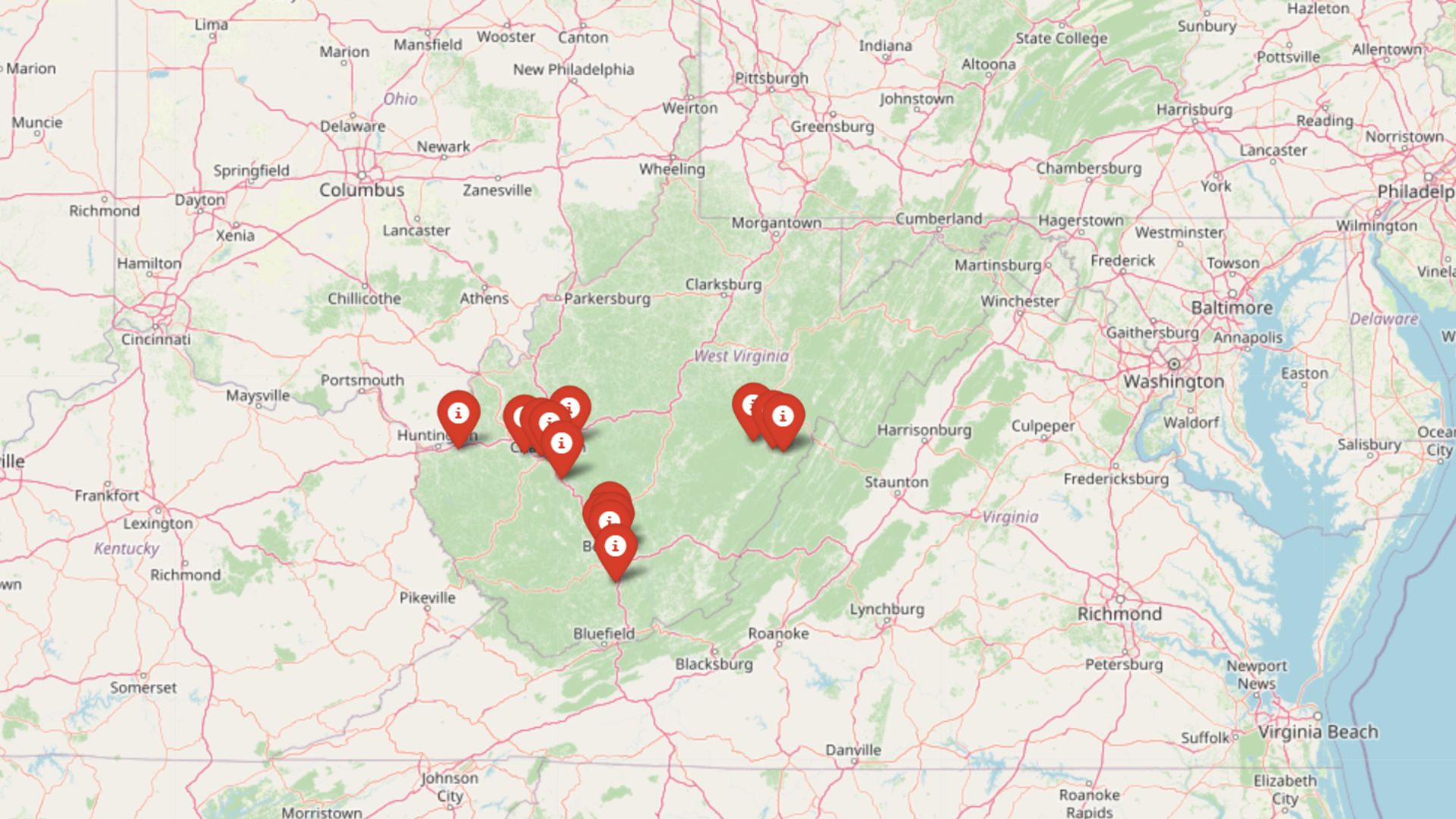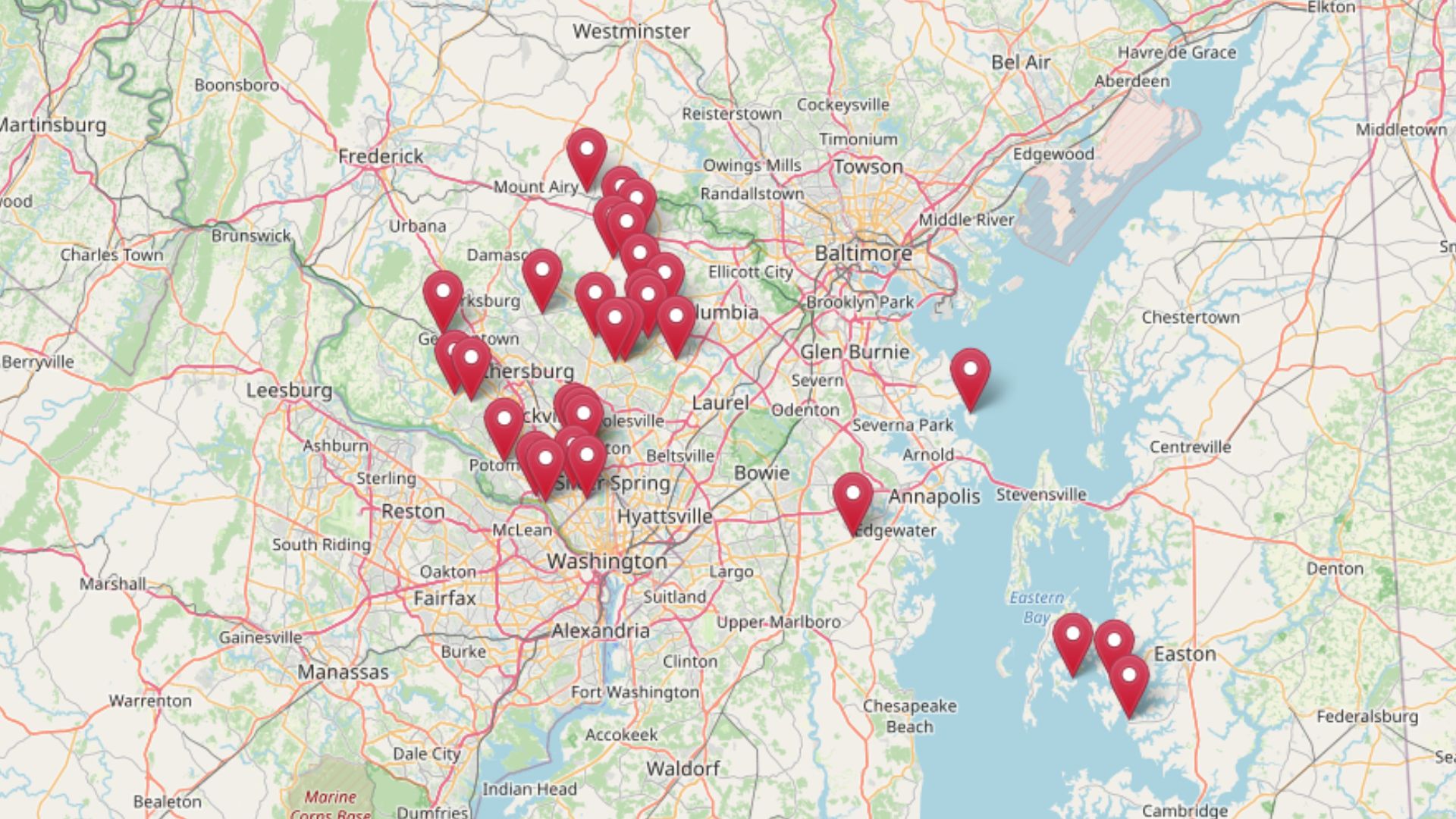
Using the latest Zillow Home Value Index data from July 2025, we’ve mapped out the 30 most expensive towns in Maryland based on current home values. These communities represent more than just high price tags—they showcase long-term wealth creation, strategic locations, and unique lifestyle offerings that command premium prices.
From exclusive waterfront enclaves to prestigious suburban havens near Washington D.C., each town on this list has carved out a distinct identity in Maryland’s luxury housing market. Home price appreciation in these areas tells a story of consistent demand, limited inventory, and the enduring appeal of communities that blend natural beauty with proximity to major employment centers.
30. Brookeville – 44% Home Price Increase Since 2010
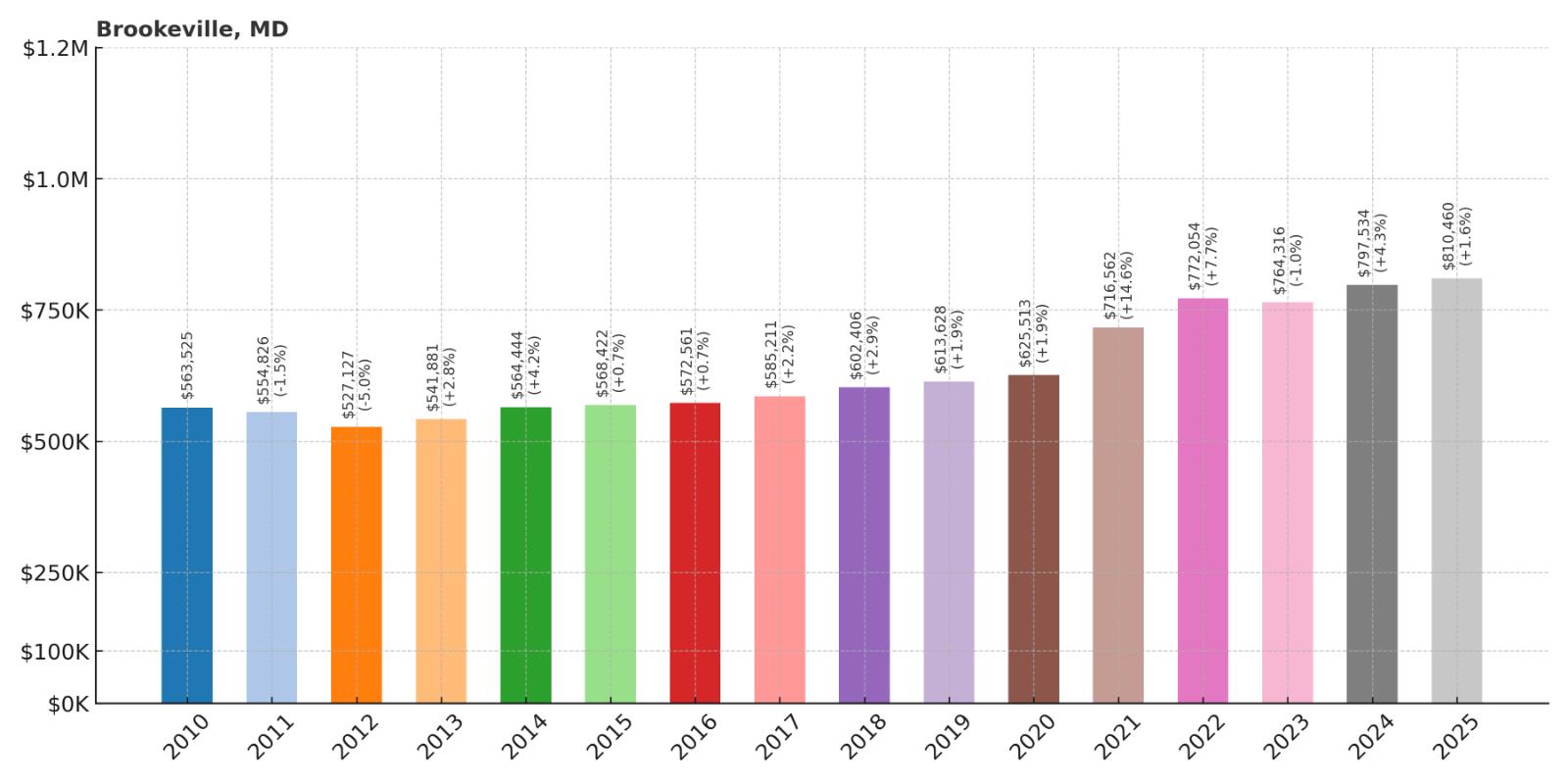
- 2010: $563,525
- 2011: $554,826
- 2012: $527,127
- 2013: $541,881
- 2014: $564,444
- 2015: $568,422
- 2016: $572,561
- 2017: $585,211
- 2018: $602,406
- 2019: $613,628
- 2020: $625,513
- 2021: $716,562
- 2022: $772,054
- 2023: $764,316
- 2024: $797,534
- 2025: $810,460
Brookeville experienced steady growth through the 2010s before accelerating dramatically during the pandemic housing boom. Values jumped nearly $147,000 between 2020 and 2022, reflecting the broader surge in demand for suburban properties. The town has maintained its upward trajectory, reaching over $810,000 by 2025.
Why Brookeville?
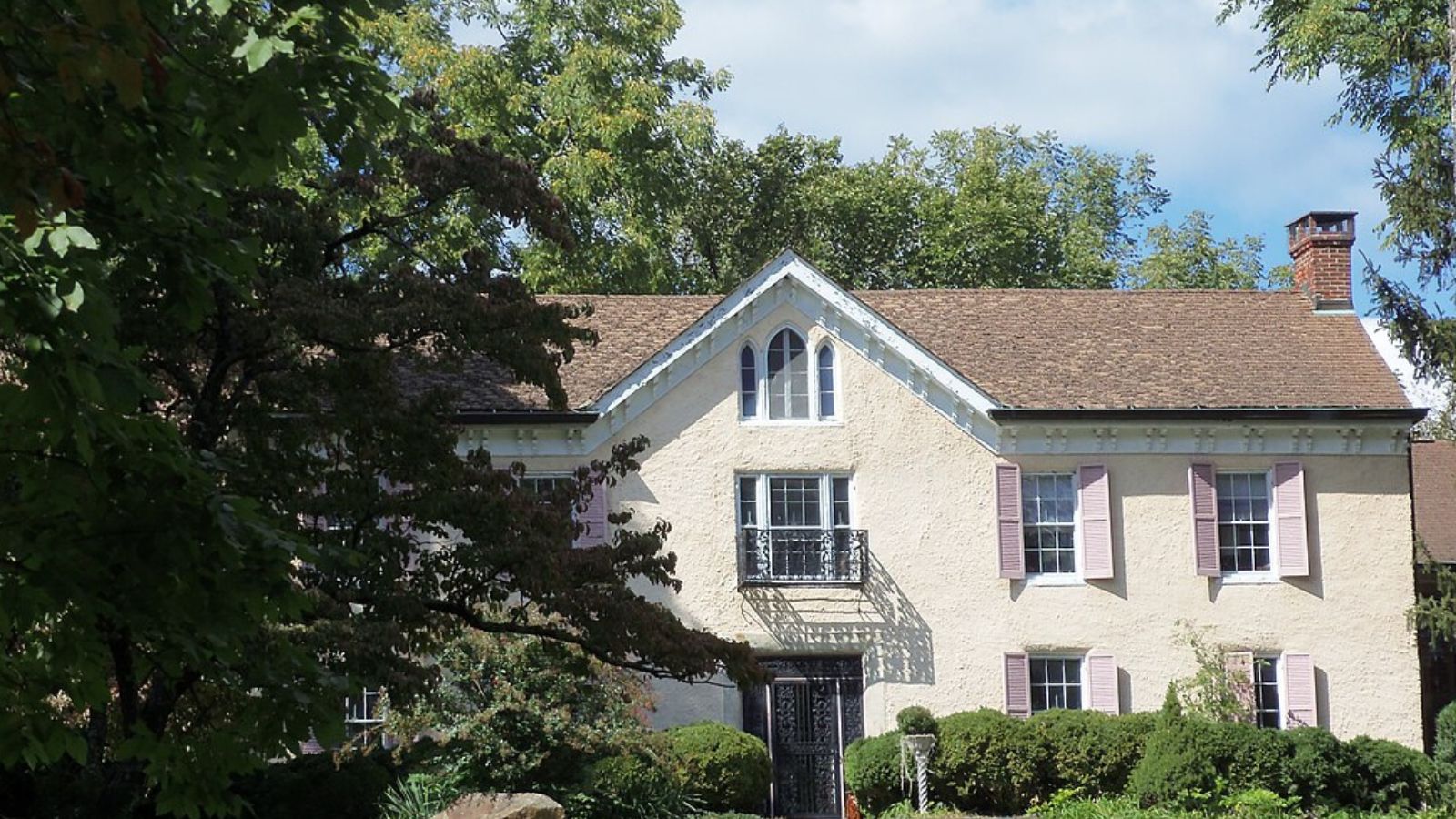
Why are people willing to pay so much to live here? What’s special about it?
Families choose Brookeville for its small-town charm combined with proximity to major employment centers in Montgomery County and Washington D.C. The historic town center provides community character while newer subdivisions offer modern amenities and larger lots. Parents value the highly-rated Montgomery County school system and the safe, walkable environment for children.
Unlike more densely developed areas, Brookeville maintains a semi-rural feel with tree-lined streets and preserved green spaces. The town’s location along Georgia Avenue provides easy commuting access while keeping the community feel intact. Strong local governance and active civic engagement help maintain property values and community standards.
How Brookeville Rose to Prominence
Founded in 1794, Brookeville gained fame as the “United States Capital for a Day” when President James Madison fled there during the War of 1812. The town remained a small agricultural community for most of its history, centered around grain mills and local farms along the Northwest Branch. Its proximity to major roads made it an important stop for travelers between Baltimore and Washington.
The transformation to a desirable residential community began in the mid-20th century as Washington’s suburban growth reached Montgomery County. Developers recognized the appeal of Brookeville’s historic charm and convenient location, leading to carefully planned subdivisions that respected the town’s character. The preservation of the historic district helped maintain property values while new construction met growing demand from professionals working in the D.C. metro area.
3 Interesting Tidbits
- Presidential Refuge – Brookeville served as the temporary U.S. capital on August 26, 1814, when President Madison stayed at the Bentley House during the British attack on Washington.
- Quaker Heritage – The town was founded by Quakers and still maintains the historic Brookeville Academy, built in 1810 as one of the first integrated schools in Maryland.
- Mill Town Legacy – The historic Thomas Mill, built in 1840, operated continuously until the 1960s and now serves as a community landmark and event venue.
29. Kensington – 51% Home Price Increase Since 2010
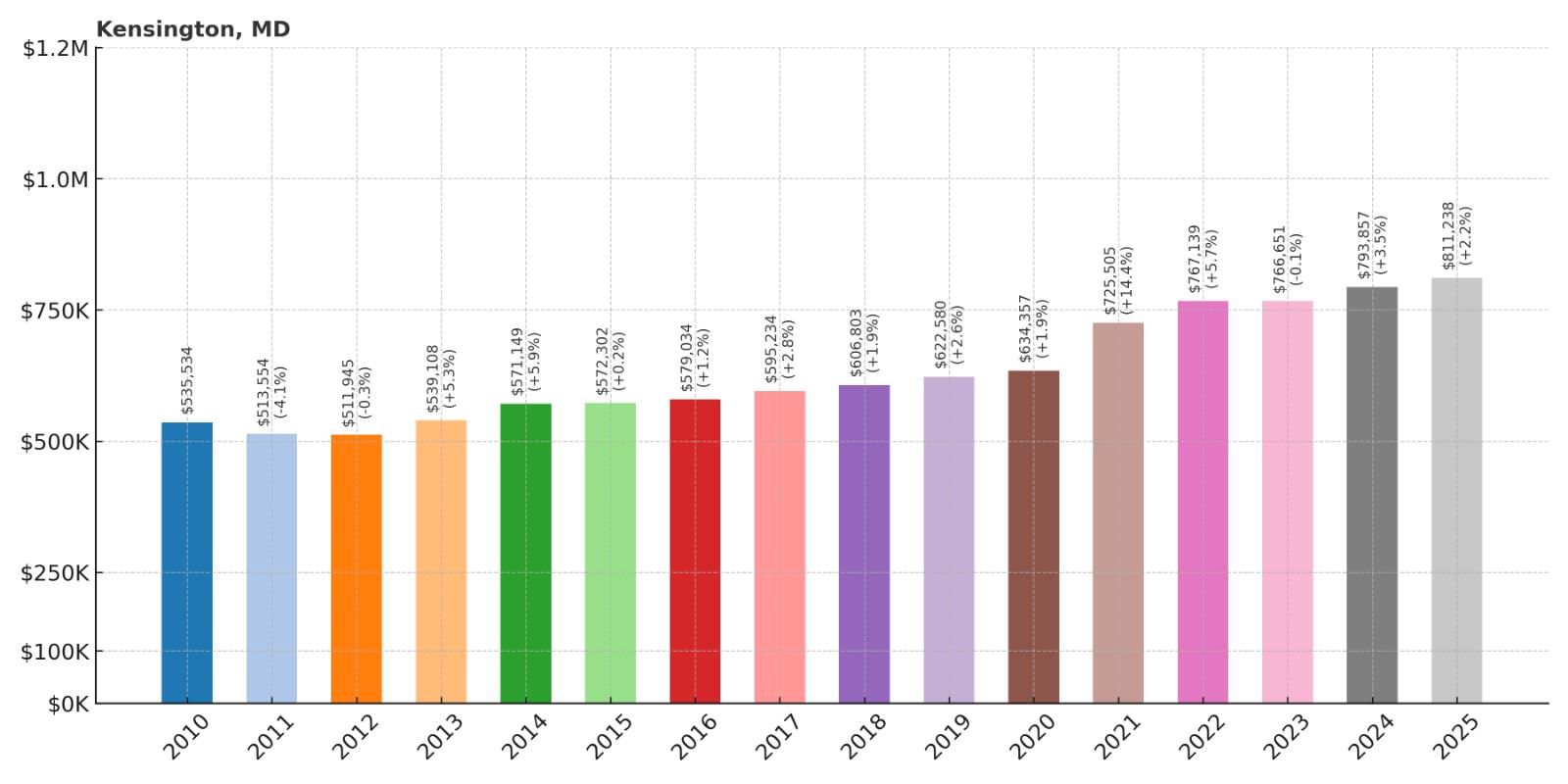
- 2010: $535,534
- 2011: $513,554
- 2012: $511,945
- 2013: $539,108
- 2014: $571,149
- 2015: $572,302
- 2016: $579,034
- 2017: $595,234
- 2018: $606,803
- 2019: $622,580
- 2020: $634,357
- 2021: $725,505
- 2022: $767,139
- 2023: $766,651
- 2024: $793,857
- 2025: $811,238
Kensington’s home values recovered from early 2010s dips to show impressive growth over the 15-year period. The most significant appreciation occurred during 2021-2022, when values jumped from $634,000 to over $767,000. Current prices above $811,000 reflect the town’s desirable location and strong community amenities.
Why Kensington?
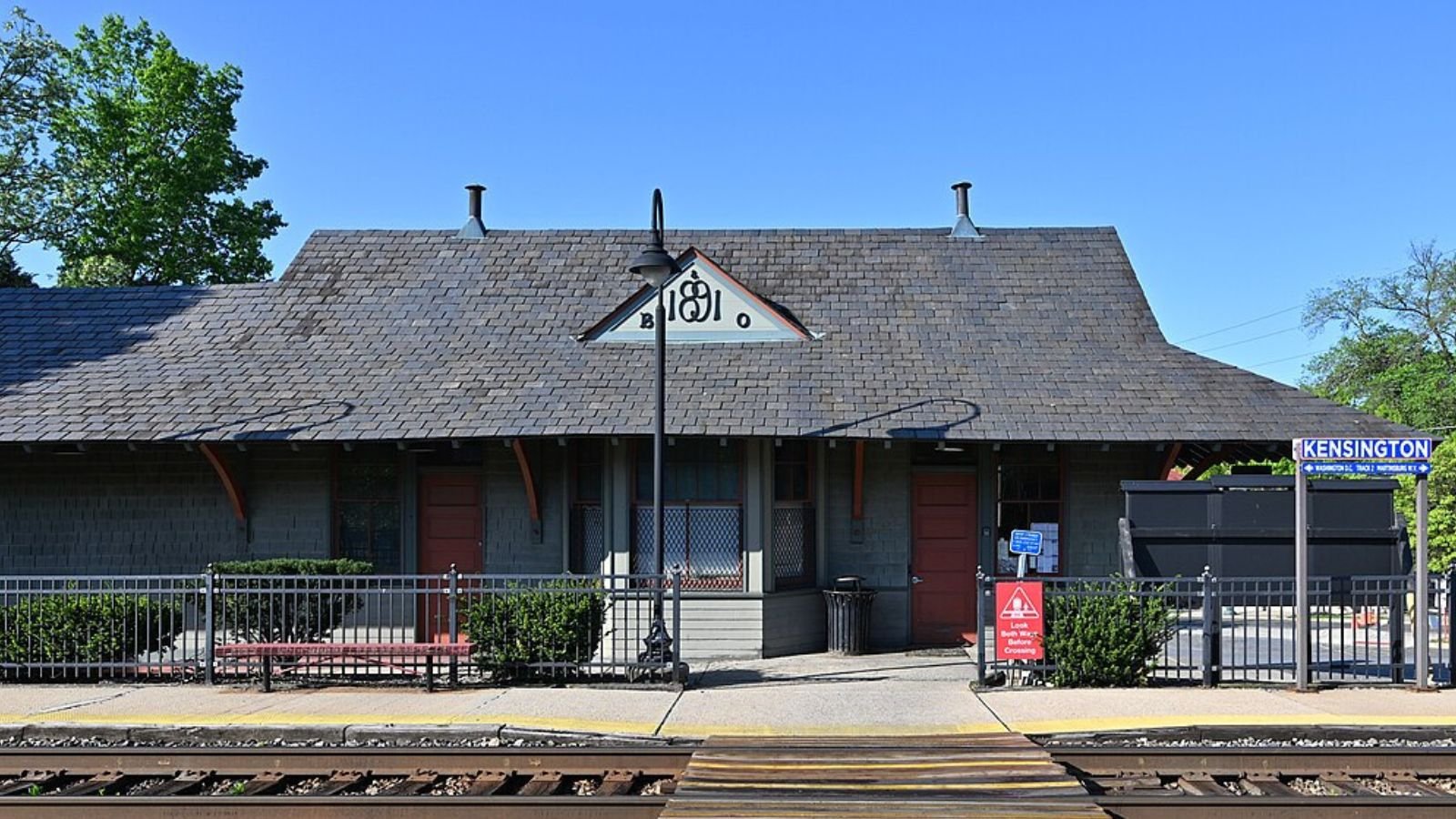
Why are people willing to pay so much to live here? What’s special about it?
Kensington attracts buyers seeking a vibrant small-town atmosphere just minutes from downtown Washington D.C. The historic downtown district features local shops, restaurants, and the popular farmers market that creates a strong sense of community. Families appreciate the walkability and the ability to access Metro via nearby stations.
The town successfully balances preservation of its early 20th-century character with modern conveniences and amenities. Tree-lined residential streets feature a mix of architectural styles from Craftsman bungalows to Colonial Revival homes. Active civic organizations and community events foster neighborhood connections that many suburban areas lack.
How Kensington Rose to Prominence
Established in 1894, Kensington began as a planned Victorian suburb designed to attract Washington commuters via the new Metropolitan Branch railroad. The town’s founders envisioned an elegant residential community with wide streets, substantial lots, and architectural restrictions to maintain quality. Early residents were primarily federal government employees and business professionals seeking refuge from city life.
The town’s incorporation in 1894 allowed residents to maintain local control over development and municipal services. Throughout the 20th century, Kensington successfully resisted suburban sprawl while accommodating growth through careful planning. The preservation of the historic commercial district and the addition of community amenities like parks and civic buildings helped establish its reputation as one of Montgomery County’s most desirable small towns.
3 Interesting Tidbits
- Antique Capital – Kensington’s historic downtown is known throughout the region for its concentration of antique shops and vintage furniture stores, drawing collectors from across the Mid-Atlantic.
- Labor Day Festival – The annual Kensington Labor Day Festival, running since 1975, attracts over 40,000 visitors and showcases the town’s strong community spirit.
- Tree City Status – Kensington has been designated a Tree City USA for over 20 consecutive years, reflecting its commitment to urban forestry and green space preservation.
28. Woodbine – 61% Home Price Increase Since 2010
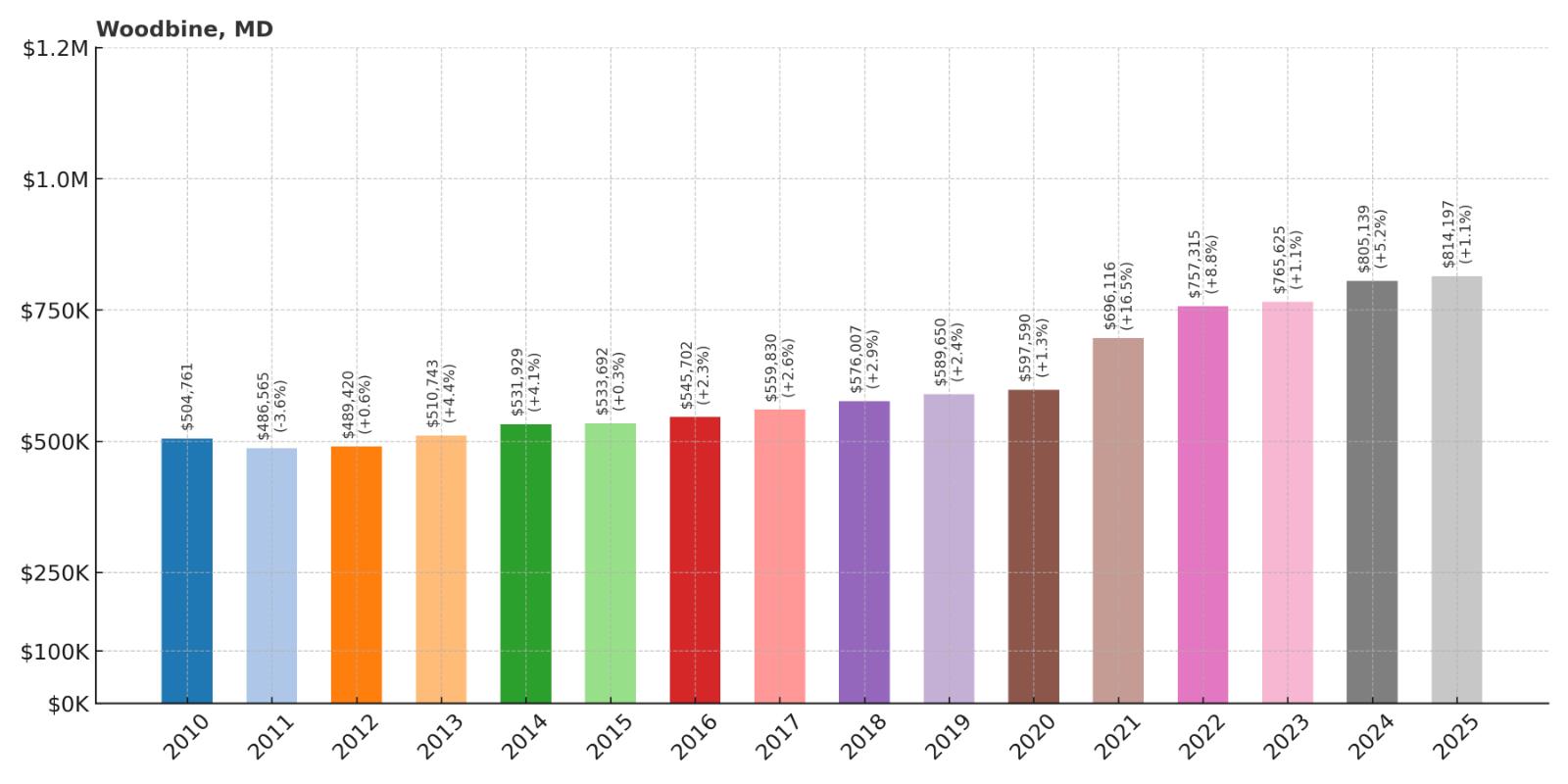
- 2010: $504,761
- 2011: $486,565
- 2012: $489,420
- 2013: $510,743
- 2014: $531,929
- 2015: $533,692
- 2016: $545,702
- 2017: $559,830
- 2018: $576,007
- 2019: $589,650
- 2020: $597,590
- 2021: $696,116
- 2022: $757,315
- 2023: $765,625
- 2024: $805,139
- 2025: $814,197
Woodbine demonstrated remarkable resilience, showing consistent growth throughout the 15-year period with particularly strong gains during the pandemic era. Values more than doubled from the 2011 low of $486,565 to today’s $814,197. The steady appreciation reflects growing demand for rural properties with urban access.
Why Woodbine?
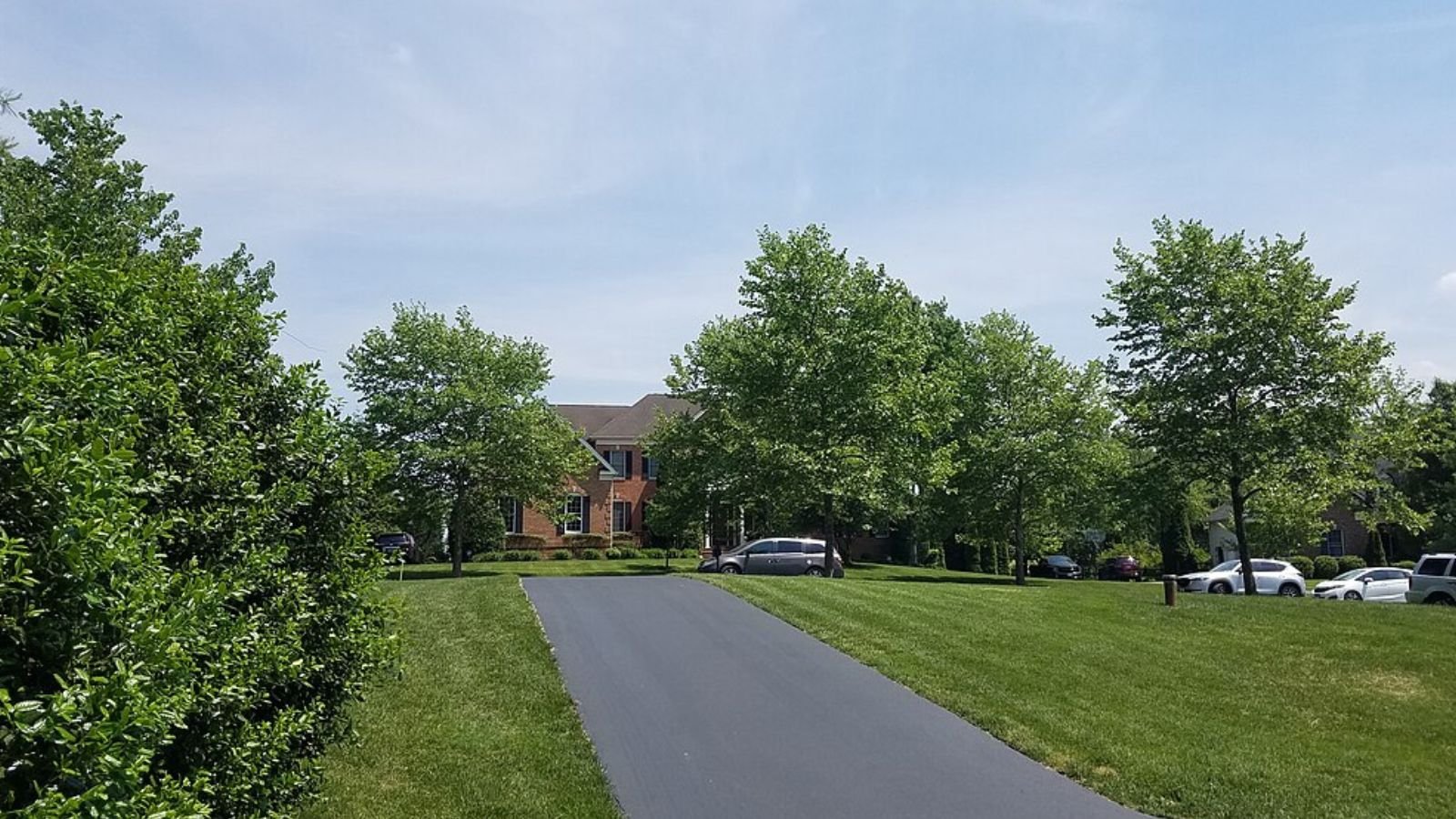
Why are people willing to pay so much to live here? What’s special about it?
Buyers are drawn to Woodbine for its combination of rural tranquility and strategic location between Baltimore and Washington corridors. Large lots and custom-built homes provide space and privacy that’s increasingly rare in the metro area. The community offers easy access to outdoor recreation while maintaining reasonable commuting distances to major employment centers.
Families value the strong Howard County school system and the safe, close-knit community atmosphere. The town’s location near Patapsco Valley State Park provides hiking, fishing, and outdoor activities that appeal to active families. Low crime rates and well-maintained infrastructure support property values and quality of life.
How Woodbine Rose to Prominence
Originally settled in the early 1800s, Woodbine developed as a railroad town along the B&O Railroad line connecting Baltimore and Washington. The town served as an important freight and passenger stop, with local businesses supporting railroad operations and travelers. Agriculture, particularly dairy farming and grain production, formed the backbone of the local economy through most of the 20th century.
The transformation to a desirable residential community began in the 1970s as suburban development spread westward from Baltimore and eastward from Washington. Developers recognized the appeal of Woodbine’s rural setting combined with railroad access for commuters. Careful zoning maintained large lot sizes and rural character while accommodating new residential development that attracted professionals seeking country living with urban convenience.
3 Interesting Tidbits
- Rail Heritage – The historic Woodbine train station, built in 1884, still operates as part of MARC’s Penn Line, providing direct service to Baltimore and Washington D.C.
- Equestrian Center – The community is home to several horse farms and the Maryland Horse Breeders Association, maintaining its rural agricultural heritage.
- Festival Grounds – Woodbine hosts the annual Celtic Festival, one of the largest Celtic cultural events on the East Coast, drawing visitors from across the region.
27. Bozman – 54% Home Price Increase Since 2010
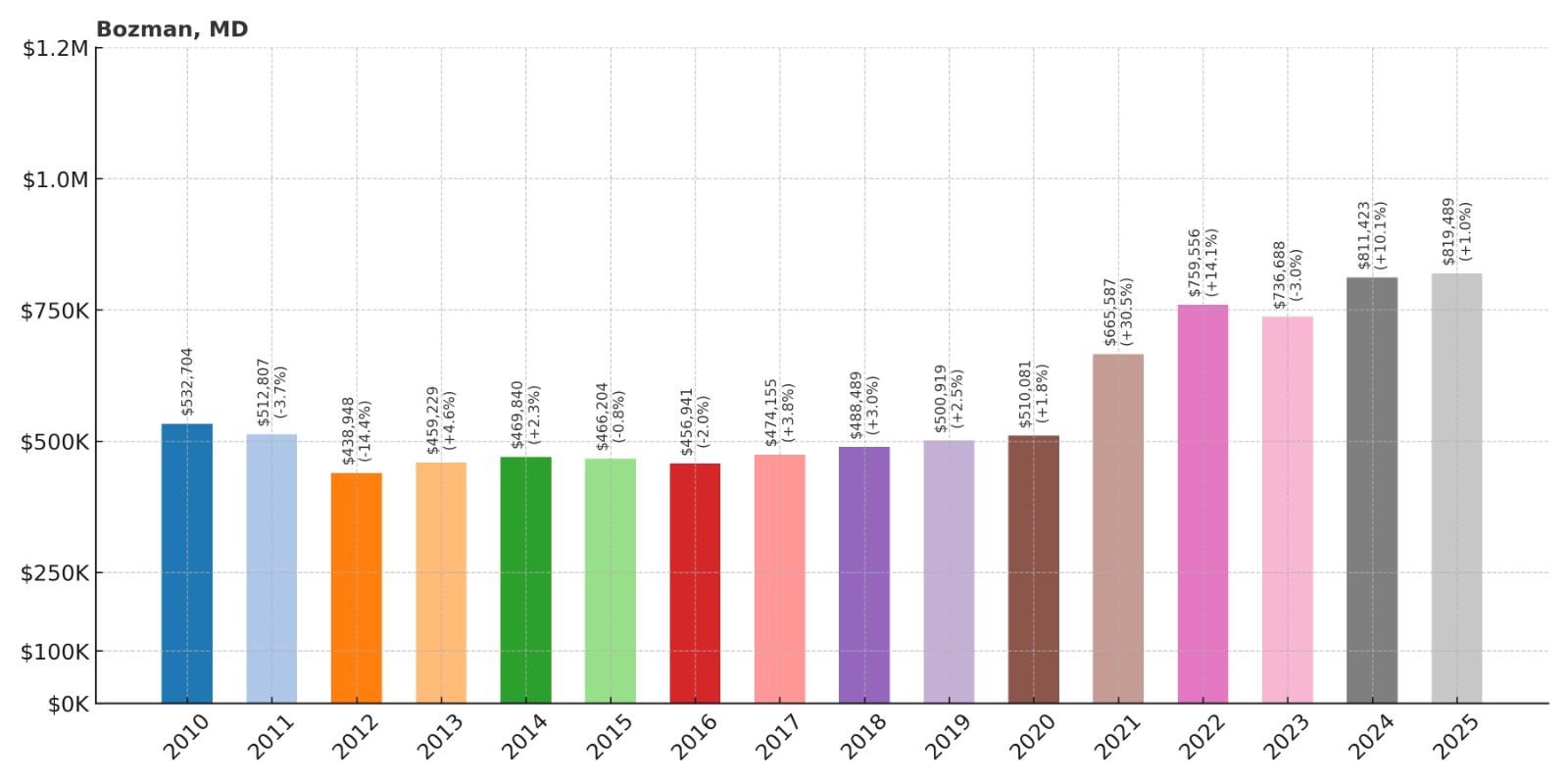
- 2010: $532,704
- 2011: $512,807
- 2012: $438,948
- 2013: $459,229
- 2014: $469,840
- 2015: $466,204
- 2016: $456,941
- 2017: $474,155
- 2018: $488,489
- 2019: $500,919
- 2020: $510,081
- 2021: $665,587
- 2022: $759,556
- 2023: $736,688
- 2024: $811,423
- 2025: $819,489
Bozman experienced significant volatility, with values dropping to $438,948 in 2012 before recovering. The most dramatic growth occurred from 2020-2022, when prices jumped from $510,081 to $759,556. Recent years show continued strength, with current values exceeding $819,000 despite some fluctuation.
Why Bozman?
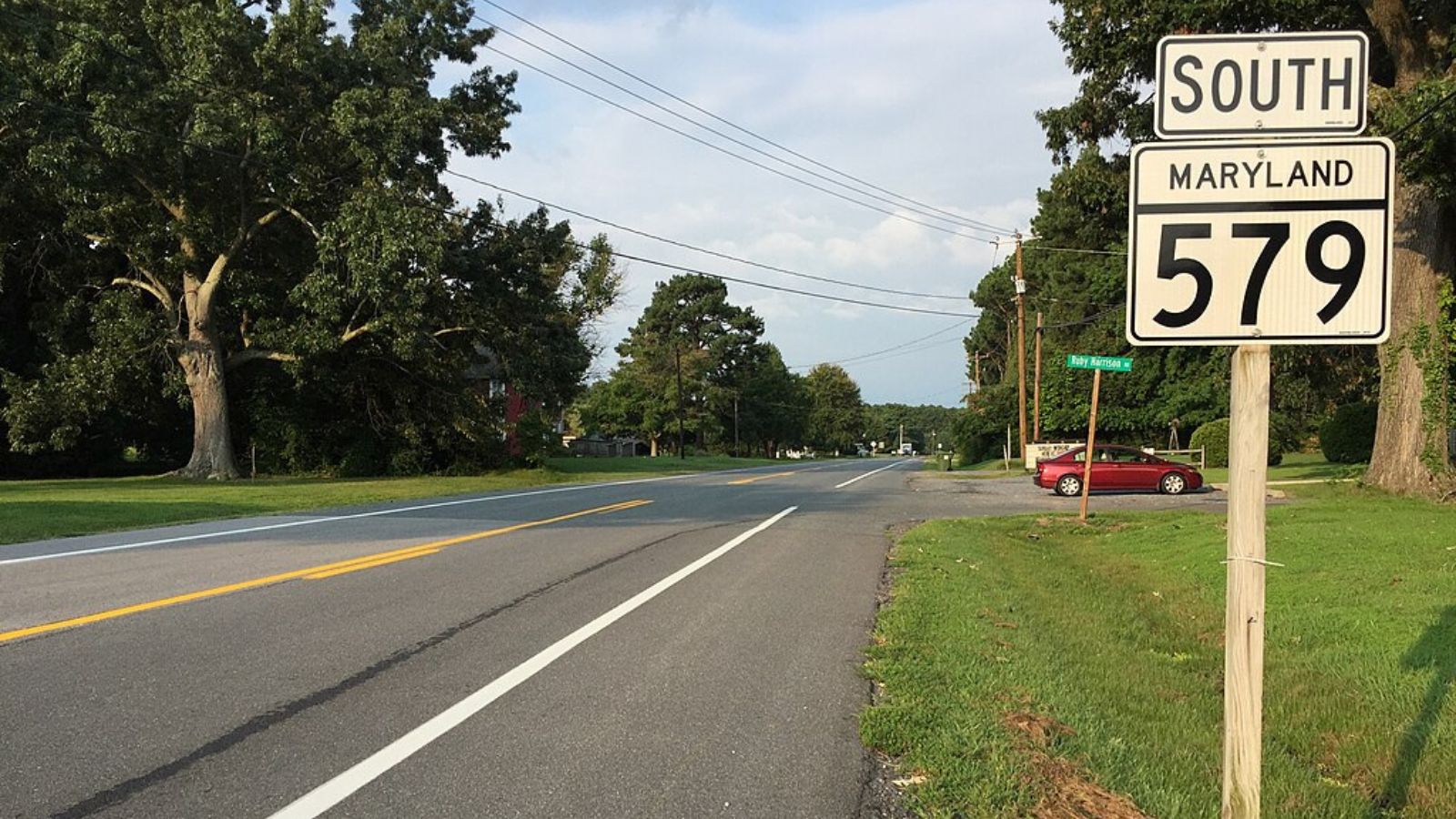
Why are people willing to pay so much to live here? What’s special about it?
Bozman appeals to buyers seeking waterfront lifestyle on Maryland’s Eastern Shore with direct access to the Chesapeake Bay. The rural community offers large waterfront lots, private docks, and unobstructed water views that command premium prices. Residents enjoy boating, fishing, and water sports while maintaining privacy and exclusivity.
The area attracts both permanent residents and second-home owners from Washington and Baltimore metro areas seeking weekend retreats. Limited development and zoning restrictions help preserve the rural character and water quality. Strong community ties and shared interest in conservation maintain property values and lifestyle quality.
How Bozman Rose to Prominence
Bozman began as a small farming and fishing village on Talbot County’s Chesapeake Bay shore in the early 1700s. The community was named after the Bozman family, early settlers who established farms and participated in the bay’s maritime economy. For most of its history, residents combined agriculture with waterman activities like oystering, crabbing, and fishing.
The transition to a desirable waterfront residential community accelerated in the late 20th century as urban professionals discovered the Eastern Shore’s appeal. Improved roads and bridge access made commuting to metropolitan areas more feasible for weekend and seasonal residents. The combination of preserved rural character, water access, and proximity to St. Michaels and Easton created a unique market position that supports premium home values.
3 Interesting Tidbits
- Maritime Heritage – Bozman Creek was historically used by skipjacks and other traditional Chesapeake Bay workboats, with several historic vessels still moored in local waters.
- Bozman United Methodist Church – The historic church, built in 1878, serves as the community’s social and spiritual center, hosting events and preserving local traditions.
- Conservation Focus – Much of the surrounding area is protected through conservation easements and environmental programs that maintain water quality and rural views.
26. Ashton – 42% Home Price Increase Since 2010
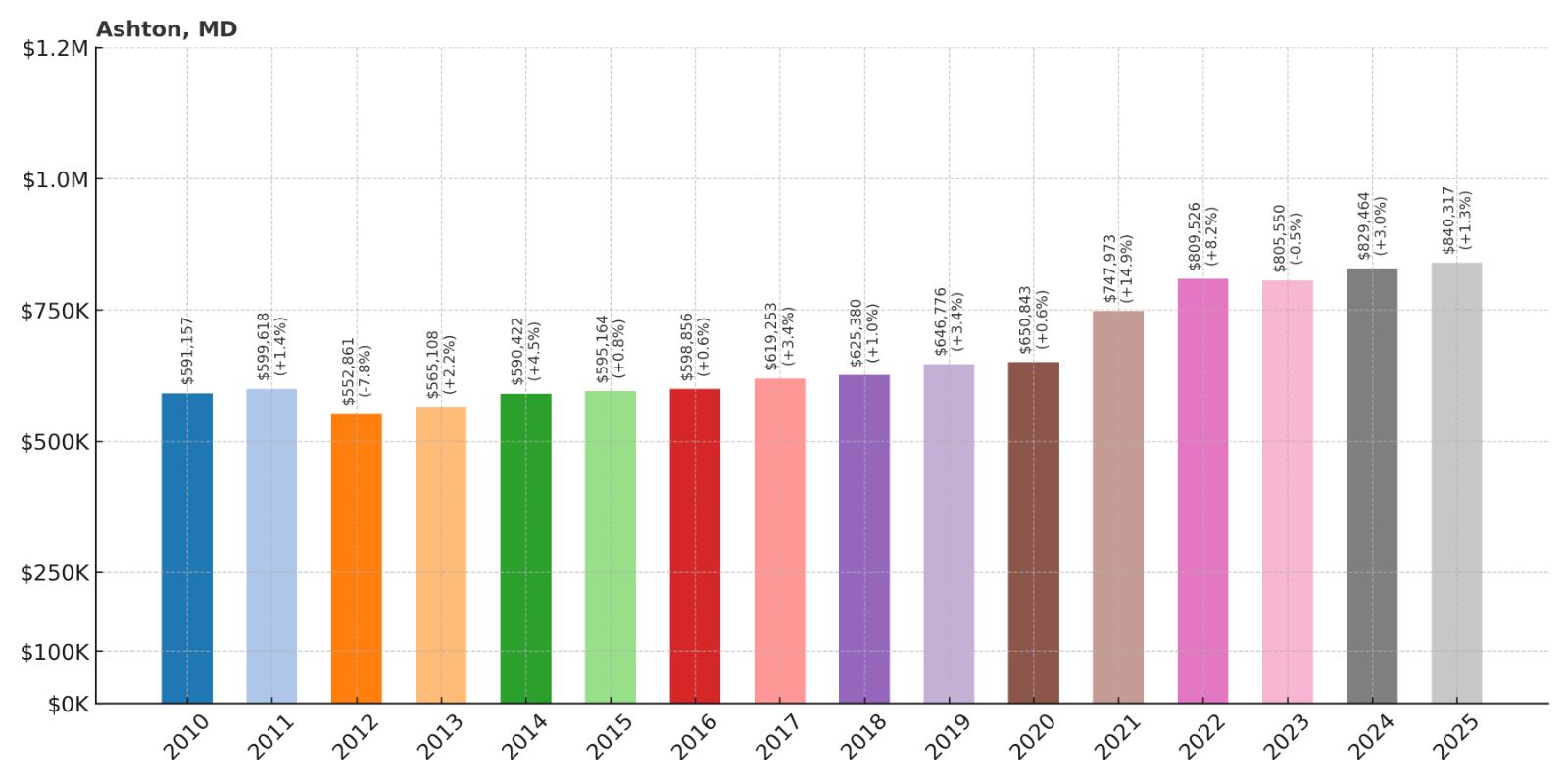
- 2010: $591,157
- 2011: $599,618
- 2012: $552,861
- 2013: $565,108
- 2014: $590,422
- 2015: $595,164
- 2016: $598,856
- 2017: $619,253
- 2018: $625,380
- 2019: $646,776
- 2020: $650,843
- 2021: $747,973
- 2022: $809,526
- 2023: $805,550
- 2024: $829,464
- 2025: $840,317
Ashton showed steady appreciation through most periods, with the biggest gains occurring during 2021-2022 when values jumped nearly $160,000. Starting from a higher baseline than many communities, the town has maintained consistent growth to reach over $840,000. The relatively smooth appreciation curve reflects stable demand and limited housing inventory.
Why Ashton?
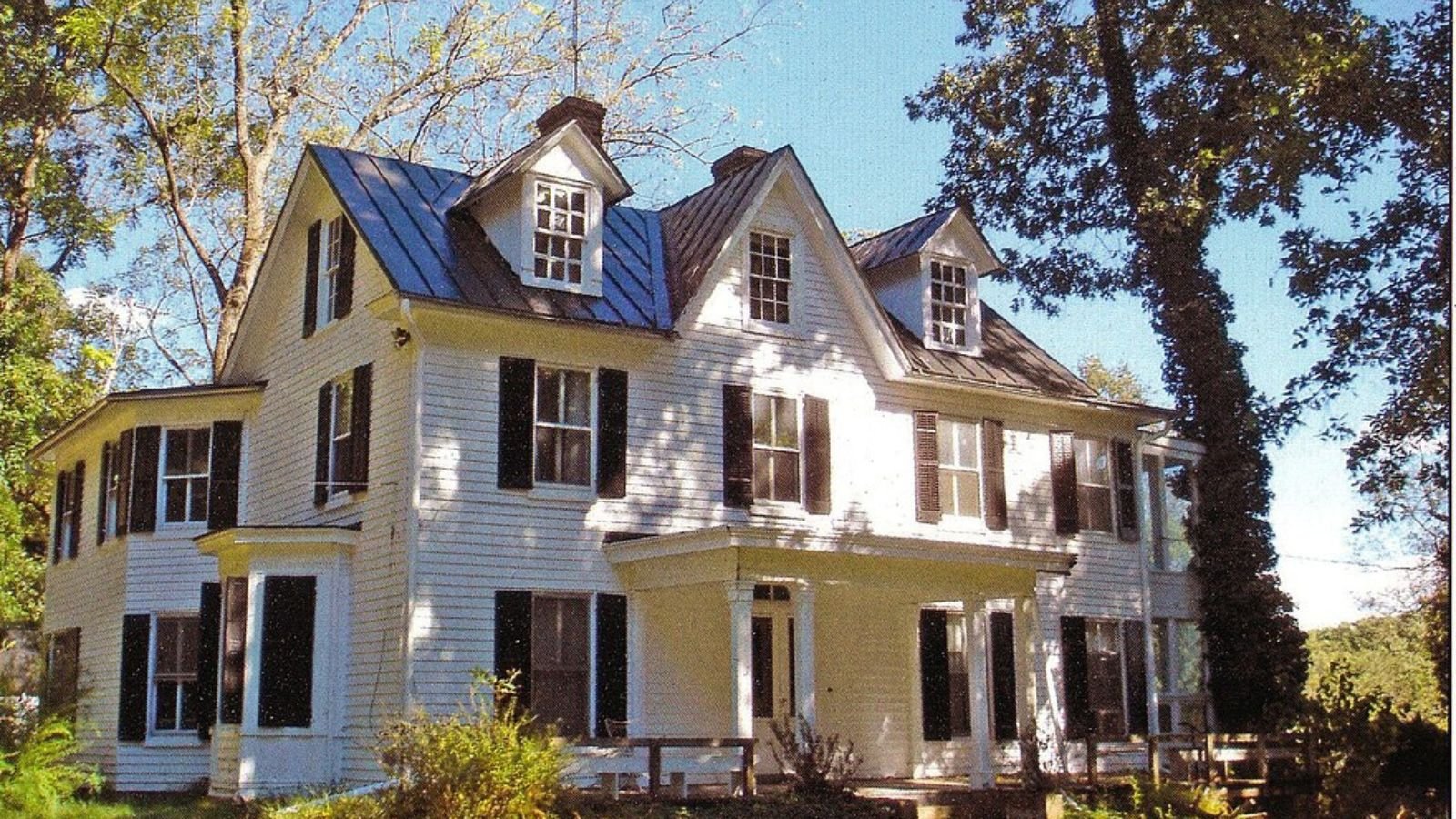
Why are people willing to pay so much to live here? What’s special about it?
Ashton attracts buyers seeking country estates and horse properties within commuting distance of Washington D.C. and Baltimore. Large lots, custom homes, and equestrian facilities appeal to affluent families who want rural lifestyle without sacrificing urban access. The Montgomery County location provides excellent public schools and county services.
The agricultural preserve zoning maintains large lot sizes and prevents suburban sprawl, protecting property values and rural character. Residents appreciate the community’s commitment to preserving farmland and open space while allowing for luxury residential development. proximity to major highways provides reasonable commuting options for professionals.
How Ashton Rose to Prominence
Established in the mid-1800s as a small farming community along the old Washington-Baltimore Pike, Ashton served local agricultural needs with mills, stores, and services. The village remained largely agricultural through most of the 20th century, with dairy farms and grain operations dominating the landscape. The B&O Railroad provided transportation for local produce and grain to urban markets.
The transformation began in the 1960s as Montgomery County’s growth pressures reached the rural areas. Rather than allowing typical suburban development, local residents and county planners worked to create agricultural preserve zoning that required large lot sizes and maintained rural character. This attracted affluent buyers seeking country estates and horse properties, establishing Ashton as one of the county’s premier rural residential areas.
3 Interesting Tidbits
- Agricultural Reserve – Ashton sits within Montgomery County’s 93,000-acre Agricultural Reserve, which maintains 5-acre minimum lot sizes and preserves farmland and rural character.
- Historic Village – The Ashton Historic District includes several 19th-century buildings, including the old general store and railroad station that serve as community landmarks.
- Equestrian Culture – The area is home to numerous horse farms, riding schools, and equestrian events that maintain the community’s rural traditions and attract horse enthusiasts.
25. Boyds – 55% Home Price Increase Since 2010
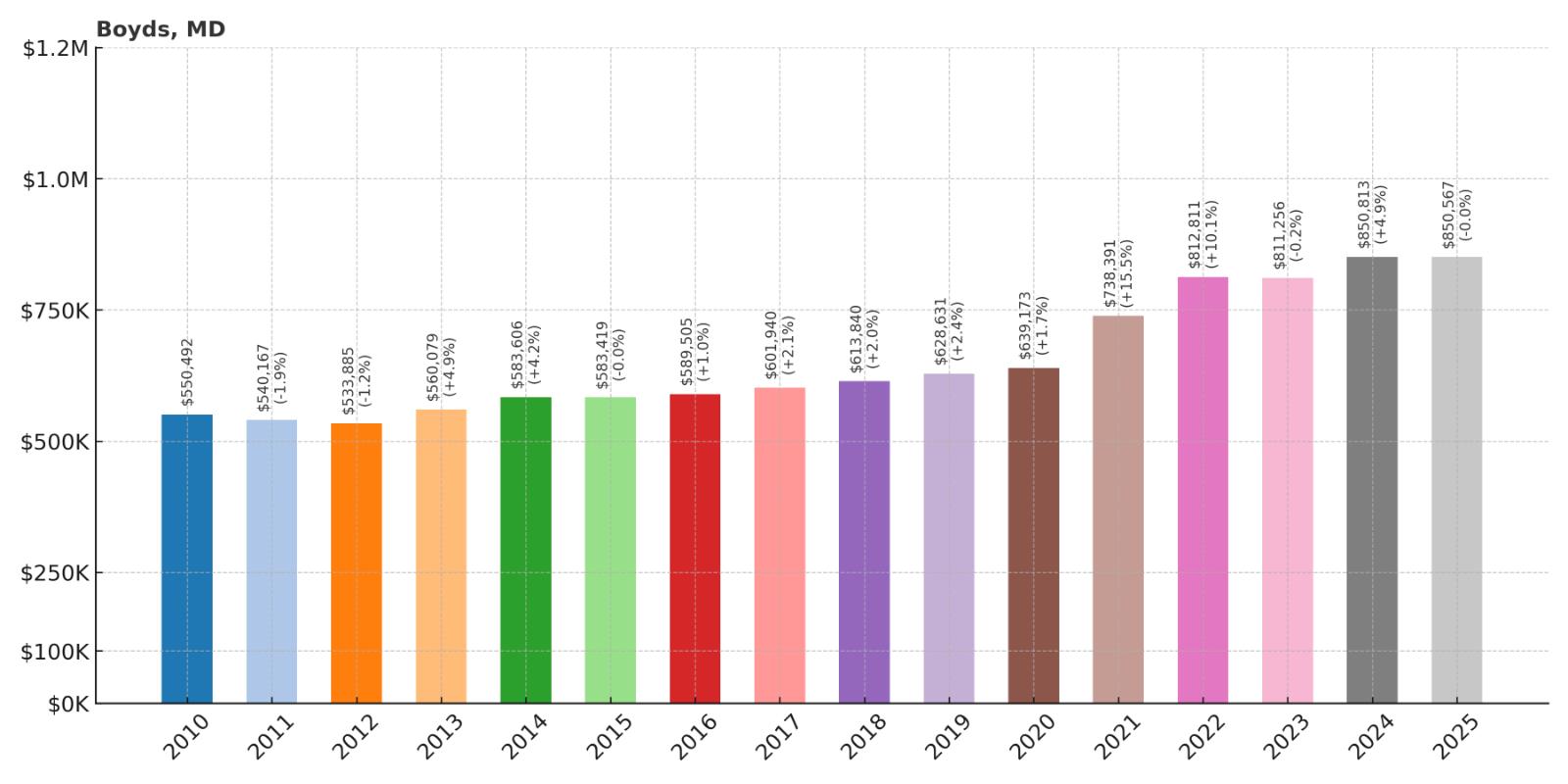
- 2010: $550,492
- 2011: $540,167
- 2012: $533,885
- 2013: $560,079
- 2014: $583,606
- 2015: $583,419
- 2016: $589,505
- 2017: $601,940
- 2018: $613,840
- 2019: $628,631
- 2020: $639,173
- 2021: $738,391
- 2022: $812,811
- 2023: $811,256
- 2024: $850,813
- 2025: $850,567
Boyds demonstrated steady growth through the 2010s before accelerating dramatically during the pandemic housing boom. Values surged from $639,173 in 2020 to over $812,000 in 2022. Recent stabilization around $850,000 reflects a mature market with strong underlying demand for rural properties near major metropolitan areas.
Why Boyds?

Why are people willing to pay so much to live here? What’s special about it?
Boyds attracts affluent families seeking large lots and custom homes within Montgomery County’s Agricultural Reserve. The rural setting provides privacy and space while maintaining access to excellent county schools and services. Residents value the community’s commitment to preserving farmland and preventing suburban sprawl.
The area appeals to professionals who can afford premium prices for country living with reasonable commuting access to Washington D.C. and Baltimore. Large lot sizes, often 5 acres or more, allow for custom homes, outbuildings, and recreational amenities. Strong property values are supported by limited inventory and zoning restrictions that prevent overdevelopment.
How Boyds Rose to Prominence
Named after the Boyd family who settled in the area in the early 1800s, Boyds developed as a small agricultural community along Clopper Road. The village centered around local mills that processed grain from surrounding farms, with the Boyd’s Mill serving as a focal point for the community. The arrival of the Metropolitan Branch railroad in the 1870s provided improved access to markets in Washington and Baltimore.
The community remained largely agricultural until Montgomery County’s post-World War II suburban expansion. However, rather than allowing typical subdivision development, residents and planners created the Agricultural Reserve in the 1980s to preserve rural character and prevent sprawl. This attracted wealthy buyers seeking large lots and country estates, transforming Boyds into one of the county’s most exclusive rural residential areas while maintaining its agricultural heritage.
3 Interesting Tidbits
- Mill Heritage – The historic Boyds Mill, built in the 1850s, operated until the 1950s and remains a community landmark along the Little Seneca Creek.
- MARC Station – The Boyds MARC station provides direct rail service to Washington D.C., making it popular with commuters seeking rural living with urban access.
- Black Hill Regional Park – This 1,834-acre park adjacent to Boyds offers hiking trails, fishing, and outdoor recreation that enhances the area’s appeal to nature-loving residents.
24. Sandy Spring – 42% Home Price Increase Since 2010
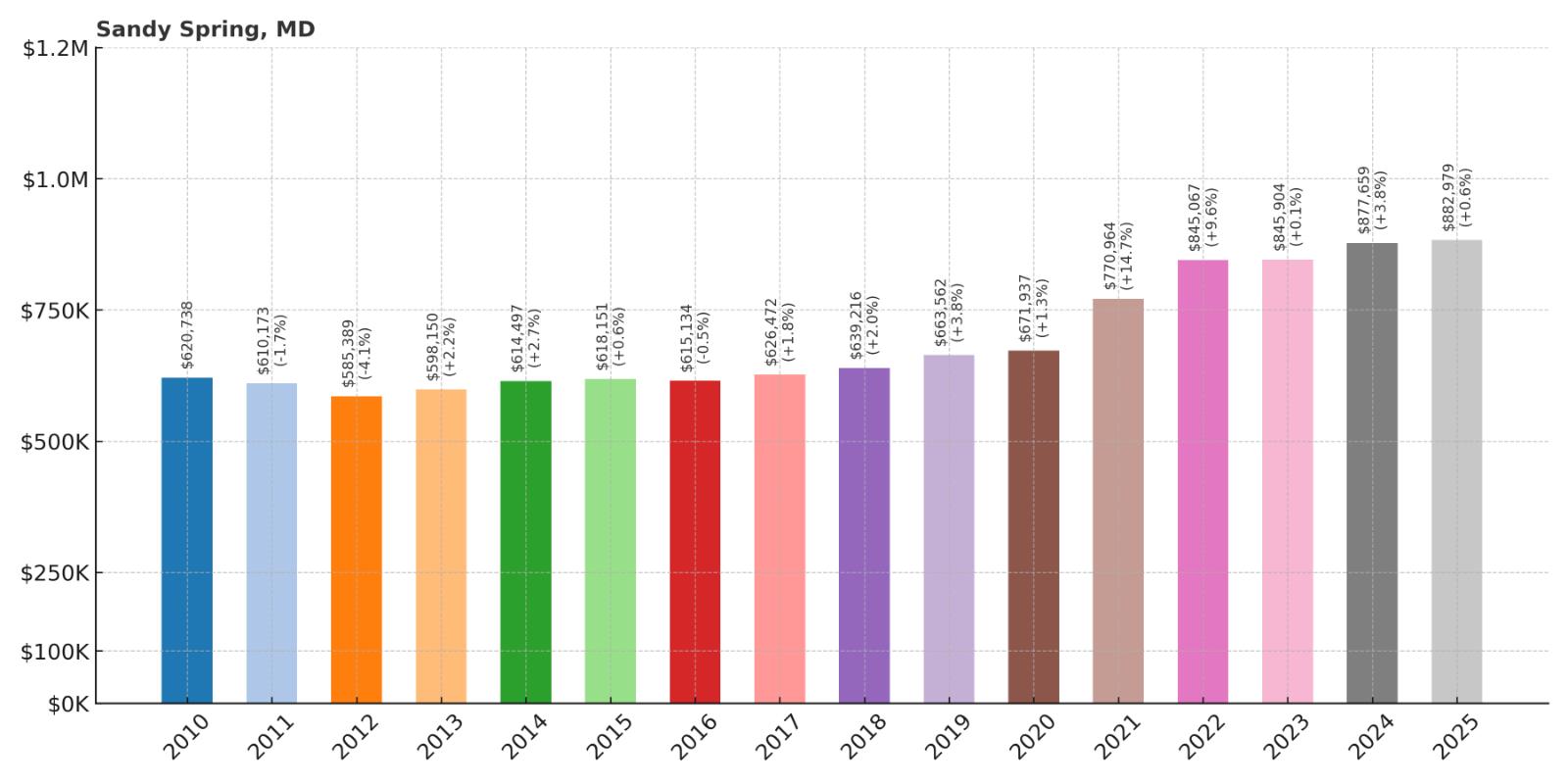
- 2010: $620,738
- 2011: $610,173
- 2012: $585,389
- 2013: $598,150
- 2014: $614,497
- 2015: $618,151
- 2016: $615,134
- 2017: $626,472
- 2018: $639,216
- 2019: $663,562
- 2020: $671,937
- 2021: $770,964
- 2022: $845,067
- 2023: $845,904
- 2024: $877,659
- 2025: $882,979
Sandy Spring maintained relatively stable values through the 2010s before experiencing significant growth during 2021-2022, jumping from $671,937 to $845,067. The town has continued steady appreciation, reaching nearly $883,000 in 2025. This growth reflects the area’s desirable combination of rural character and proximity to major employment centers.
Why Sandy Spring?

Why are people willing to pay so much to live here? What’s special about it?
Sandy Spring appeals to families seeking a historic community with strong educational traditions and rural charm within Montgomery County. The area features large lots, mature trees, and architectural diversity from Colonial to contemporary styles. Residents value the community’s commitment to historic preservation and environmental stewardship.
The Sandy Spring Friends School and other private institutions create an educational focus that attracts families prioritizing academics. Community organizations and cultural events foster strong social connections among residents. The agricultural preserve zoning maintains open space and prevents suburban sprawl while supporting premium property values.
How Sandy Spring Rose to Prominence
Founded by Quakers in 1728, Sandy Spring became one of Maryland’s earliest and most important Quaker settlements. The community developed around the Sandy Spring Friends Meeting House and emphasized education, establishing schools and libraries that served the broader region. The name derives from a natural spring with sandy banks that provided water for the settlement and travelers.
Throughout the 19th and early 20th centuries, Sandy Spring maintained its identity as an educational and cultural center while remaining primarily agricultural. The community’s commitment to education and social progress attracted prominent families and institutions. Post-World War II suburban growth brought new residents who appreciated the area’s history and rural character, leading to careful development that preserved the community’s essential character while accommodating growth.
3 Interesting Tidbits
- Quaker Heritage – The Sandy Spring Friends Meeting, established in 1753, is one of the oldest continuously operating Quaker meetings in Maryland and remains active today.
- Educational Legacy – Sandy Spring Friends School, founded in 1961, continues the community’s 250-year tradition of progressive education on a beautiful 140-acre campus.
- Underground Railroad – Several homes in Sandy Spring served as stations on the Underground Railroad, reflecting the Quaker community’s commitment to abolition and social justice.
23. North Potomac – 45% Home Price Increase Since 2010
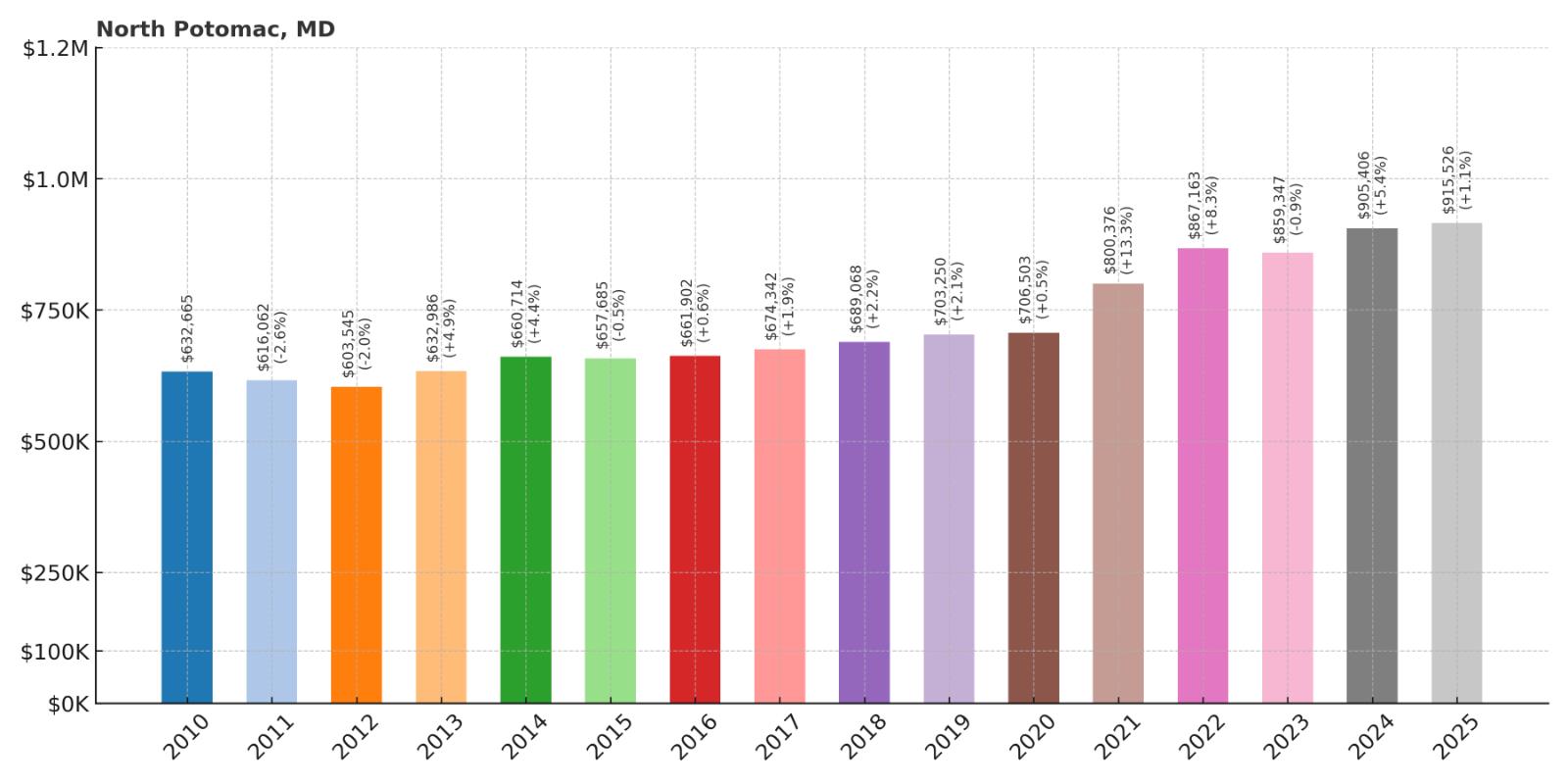
- 2010: $632,665
- 2011: $616,062
- 2012: $603,545
- 2013: $632,986
- 2014: $660,714
- 2015: $657,685
- 2016: $661,902
- 2017: $674,342
- 2018: $689,068
- 2019: $703,250
- 2020: $706,503
- 2021: $800,376
- 2022: $867,163
- 2023: $859,347
- 2024: $905,406
- 2025: $915,526
North Potomac showed consistent growth throughout the 15-year period, with particularly strong performance during 2021-2024. Values have increased from $632,665 in 2010 to over $915,000 in 2025. The steady appreciation reflects the community’s appeal to affluent families and its strategic location within Montgomery County.
Why North Potomac?

Why are people willing to pay so much to live here? What’s special about it?
North Potomac attracts families seeking excellent schools, diverse neighborhoods, and convenient access to Washington D.C. and the I-270 technology corridor. The community features a mix of housing options from townhomes to luxury estates, accommodating various lifestyle preferences. Residents appreciate the multicultural environment and strong educational opportunities.
The area benefits from Montgomery County’s excellent public services and schools while offering newer neighborhoods with modern amenities. Shopping, dining, and recreational facilities provide convenience and lifestyle options. Strong job growth in nearby technology and biomedical sectors supports household incomes that justify premium housing costs.
How North Potomac Rose to Prominence
North Potomac didn’t exist as a distinct community until the 1980s, when rapid suburban development transformed former farmland into planned residential neighborhoods. The area was previously part of the broader Potomac region, consisting primarily of dairy farms and rural estates. The construction of Interstate 270 and other highway improvements made the area attractive to developers and homebuyers.
The community gained formal recognition in 1989 when the U.S. Postal Service approved “North Potomac” as a mailing address, distinguishing it from nearby Potomac. Planned developments like Quince Orchard and Darnestown attracted affluent families with children, creating demand for schools, shopping, and services. The area’s proximity to major employment centers in Rockville, Gaithersburg, and Washington D.C. supported continued growth and rising home values.
3 Interesting Tidbits
- Multicultural Community – North Potomac has one of the highest concentrations of Asian-American residents in Maryland, creating a vibrant multicultural environment with diverse dining and cultural offerings.
- Top Schools – The area is served by some of Montgomery County’s highest-rated schools, including Quince Orchard High School, which consistently ranks among the best in Maryland.
- New Town Success – Money Inc. and Niche have ranked North Potomac as the best place to live in Maryland multiple times, citing schools, safety, and economic opportunity.
22. Oxford – 42% Home Price Increase Since 2010
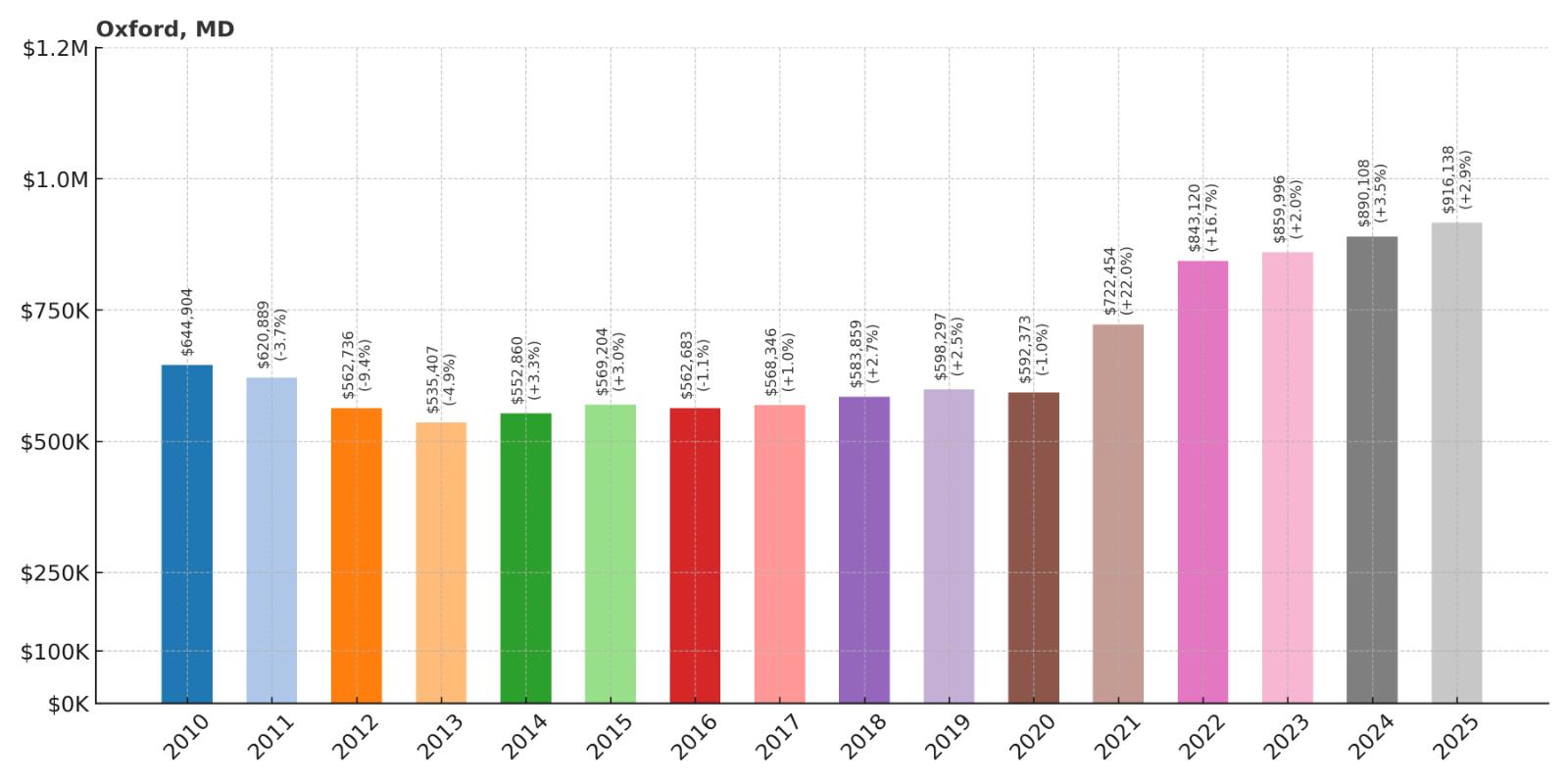
- 2010: $644,904
- 2011: $620,889
- 2012: $562,736
- 2013: $535,407
- 2014: $552,860
- 2015: $569,204
- 2016: $562,683
- 2017: $568,346
- 2018: $583,859
- 2019: $598,297
- 2020: $592,373
- 2021: $722,454
- 2022: $843,120
- 2023: $859,996
- 2024: $890,108
- 2025: $916,138
Oxford experienced significant volatility, with values dropping to $535,407 in 2013 before recovering. The most dramatic growth occurred from 2020-2022, when prices surged from $592,373 to $843,120. Recent years show continued strength, with current values exceeding $916,000, reflecting the desirability of this historic Eastern Shore waterfront community.
Why Oxford?

Why are people willing to pay so much to live here? What’s special about it?
Oxford draws buyers seeking waterfront living in one of Maryland’s most historic and picturesque towns. The Tred Avon River location provides deep-water access for boating enthusiasts while the colonial architecture and tree-lined streets create exceptional charm. Limited development and strict zoning preserve the town’s character and support premium property values.
The community attracts both full-time residents and second-home owners from Washington and Baltimore seeking refuge from urban life. World-class restaurants, boutique shopping, and cultural amenities provide sophisticated lifestyle options. The ferry to nearby St. Michaels and proximity to Easton offer additional recreational and cultural opportunities.
How Oxford Rose to Prominence
Founded in 1683, Oxford was one of Maryland’s first official ports of entry and rivaled Annapolis in importance during colonial times. The town served as a major tobacco shipping point and international trade center, with ships sailing directly to London and other European ports. Oxford’s strategic location on the Tred Avon River made it a natural harbor for the Chesapeake Bay’s maritime commerce.
After declining in the 19th century as Baltimore gained prominence, Oxford reinvented itself as a retreat for wealthy urbanites in the early 20th century. The preservation of colonial architecture and waterfront character attracted summer residents and eventually year-round retirees. The town’s commitment to maintaining its historic charm while providing modern amenities has created one of the Eastern Shore’s most exclusive residential markets.
3 Interesting Tidbits
- Ferry Connection – The Oxford-Bellevue Ferry, operating since 1683, is the oldest privately operated ferry service in the United States and provides scenic transport to St. Michaels.
- Strand Theatre – This restored 1950s movie theater serves as the town’s cultural centerpiece, hosting films, live performances, and community events year-round.
- Robert Morris Inn – Dating to 1710, this historic inn hosted founding fathers and remains one of the Eastern Shore’s most celebrated restaurants and gathering places.
21. Brinklow – 7% Home Price Increase Since 2022
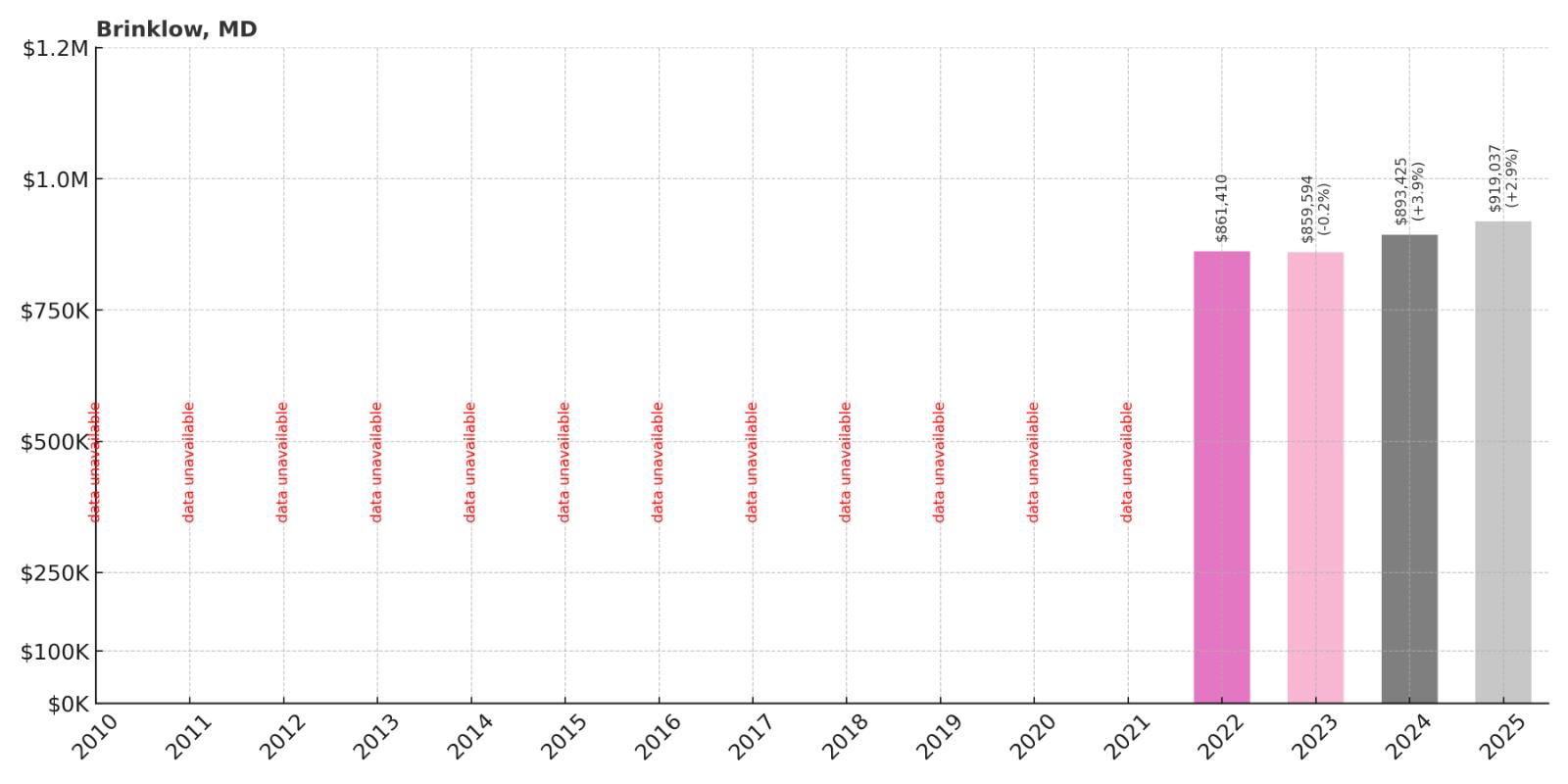
- 2010: N/A
- 2011: N/A
- 2012: N/A
- 2013: N/A
- 2014: N/A
- 2015: N/A
- 2016: N/A
- 2017: N/A
- 2018: N/A
- 2019: N/A
- 2020: N/A
- 2021: N/A
- 2022: $861,410
- 2023: $859,594
- 2024: $893,425
- 2025: $919,037
Brinklow shows limited historical data, with tracking beginning in 2022 at $861,410. Despite a slight dip in 2023, values have grown steadily to exceed $919,000 in 2025. The 7% increase since 2022 reflects a stable, mature market with strong underlying demand for rural properties in Montgomery County.
Why Brinklow?

Why are people willing to pay so much to live here? What’s special about it?
Brinklow attracts affluent families seeking large estates and horse properties within Montgomery County’s Agricultural Reserve. The rural setting provides privacy and space for custom homes, outbuildings, and recreational amenities while maintaining access to excellent county services. Residents value the community’s commitment to preserving farmland and open space.
The area appeals to equestrian enthusiasts and those seeking country lifestyle with reasonable access to Washington D.C. and Baltimore. Large lot sizes, often 5-25 acres, support premium home values and exclusive residential development. Strong zoning restrictions prevent suburban sprawl and maintain the rural character that defines the community’s appeal.
How Brinklow Rose to Prominence
Established in the mid-1800s as a small farming community along the old Washington-Baltimore road, Brinklow served local agricultural needs with a general store, post office, and grain elevator. The village remained largely agricultural through most of the 20th century, with dairy farms and grain operations dominating the landscape surrounding the small commercial center.
The transformation began in the 1980s when Montgomery County created the Agricultural Reserve to preserve rural character and prevent suburban sprawl. Rather than allowing typical subdivision development, the reserve requires large lot sizes and maintains agricultural zoning. This attracted wealthy buyers seeking country estates and horse properties, establishing Brinklow as one of the county’s most exclusive rural residential areas while preserving its agricultural heritage.
3 Interesting Tidbits
- Agricultural Reserve – Brinklow sits within Montgomery County’s 93,000-acre Agricultural Reserve, which preserves farmland and requires minimum 5-acre lot sizes for residential development.
- Historic Crossroads – The community developed around the intersection of major colonial-era roads connecting Washington, Baltimore, and Frederick, with several historic buildings still standing.
- Equestrian Center – The area is home to numerous horse farms, riding schools, and the Sandy Spring Friends School’s equestrian program, maintaining its rural traditions.
20. Laytonsville – 6% Home Price Increase Since 2022

- 2010: N/A
- 2011: N/A
- 2012: N/A
- 2013: N/A
- 2014: N/A
- 2015: N/A
- 2016: N/A
- 2017: N/A
- 2018: N/A
- 2019: N/A
- 2020: N/A
- 2021: N/A
- 2022: $881,457
- 2023: $869,595
- 2024: $904,017
- 2025: $931,768
Laytonsville entered tracking in 2022 at $881,457 with modest growth since then. Values dipped slightly in 2023 before recovering to exceed $931,000 in 2025. The 6% increase since 2022 indicates a stable luxury market with consistent demand for rural properties near major metropolitan areas.
Why Laytonsville?

Why are people willing to pay so much to live here? What’s special about it?
Laytonsville attracts buyers seeking country estates and horse properties within Montgomery County’s Agricultural Reserve. The rural community offers large lots, custom homes, and equestrian facilities while maintaining access to excellent schools and county services. Residents value the peaceful setting and strong community connections fostered by shared rural interests.
The area appeals to affluent professionals who want space, privacy, and rural amenities with reasonable commuting access to Washington D.C. and Baltimore. Large lot requirements and agricultural zoning maintain property values by preventing overdevelopment. The community’s commitment to preserving farmland and open space supports premium pricing for available properties.
How Laytonsville Rose to Prominence
Named after the Layton family who settled in the area in the early 1800s, Laytonsville developed as a small agricultural village serving local farming communities. The village centered around a general store, post office, and several churches that provided social and commercial focal points for surrounding farms. The arrival of the railroad in the late 1800s improved access to markets in Washington and Baltimore.
The community remained primarily agricultural until Montgomery County’s suburban expansion after World War II. However, rather than allowing typical residential development, the county created agricultural zoning that required large lots and preserved rural character. This attracted wealthy buyers seeking country properties, transforming Laytonsville into an exclusive rural residential area while maintaining its agricultural heritage and small-town atmosphere.
3 Interesting Tidbits
- Historic Village – The Laytonsville Historic District includes several 19th-century buildings, including the old general store and Methodist church that anchor the village center.
- Agricultural Heritage – The annual Laytonsville Community Day celebrates the area’s farming heritage with demonstrations, local crafts, and traditional foods.
- Nature Preserve – The nearby Rachel Carson Conservation Park provides hiking trails and environmental education programs that enhance the community’s rural appeal.
19. Cooksville – 61% Home Price Increase Since 2010
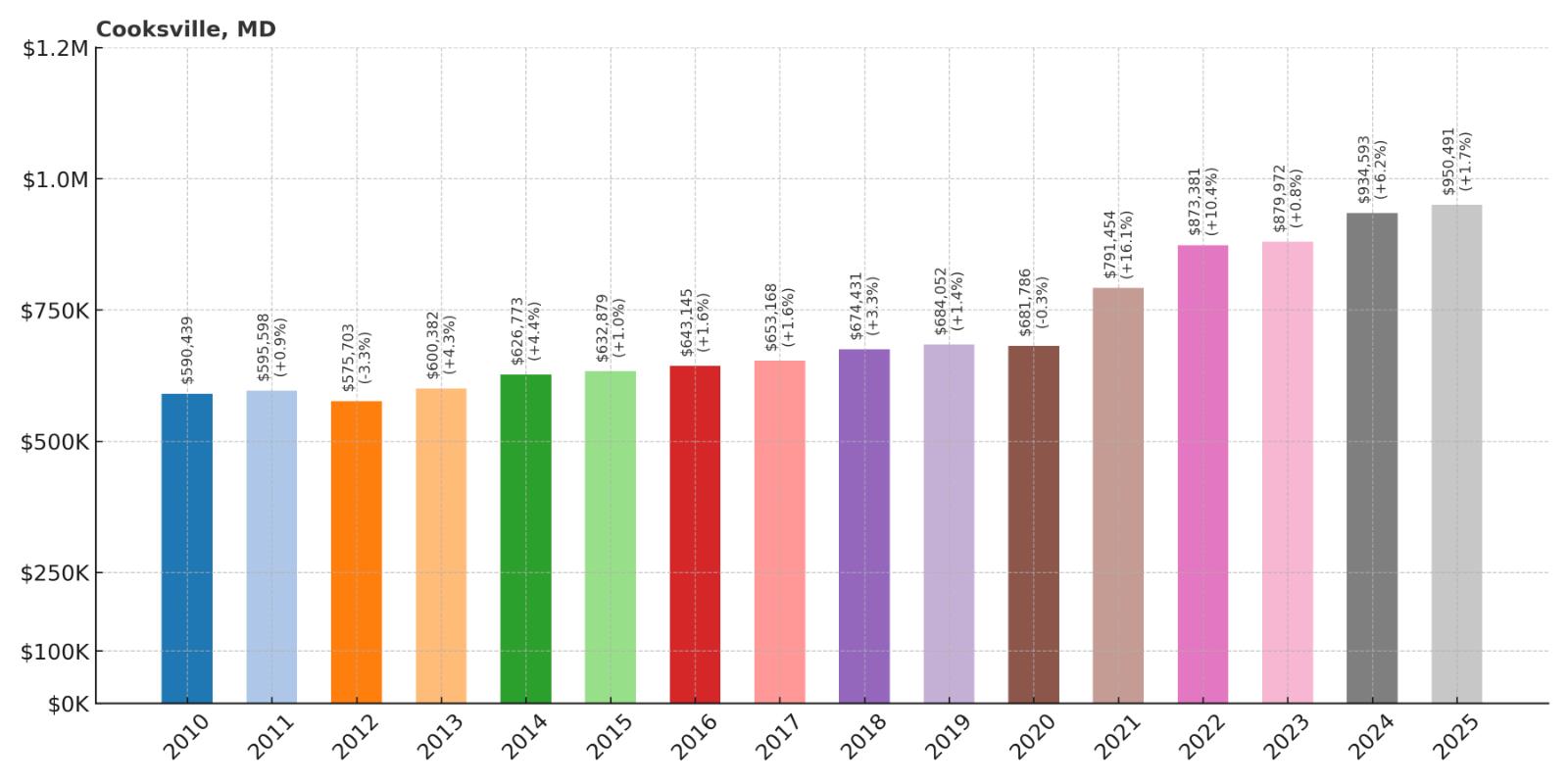
- 2010: $590,439
- 2011: $595,598
- 2012: $575,703
- 2013: $600,382
- 2014: $626,773
- 2015: $632,879
- 2016: $643,145
- 2017: $653,168
- 2018: $674,431
- 2019: $684,052
- 2020: $681,786
- 2021: $791,454
- 2022: $873,381
- 2023: $879,972
- 2024: $934,593
- 2025: $950,491
Cooksville demonstrated steady growth throughout the 15-year period before accelerating significantly during the pandemic era. Values jumped from $681,786 in 2020 to $873,381 in 2022, with continued strong growth reaching $950,491 in 2025. The 61% increase since 2010 reflects growing demand for rural properties with urban access.
Why Cooksville?

Why are people willing to pay so much to live here? What’s special about it?
Cooksville appeals to affluent families seeking rural tranquility within Howard County, known for its excellent schools and planned communities. The area offers large lots, custom homes, and country atmosphere while maintaining convenient access to Baltimore and Washington employment centers. Residents value the combination of space, privacy, and proximity to urban amenities.
The community attracts professionals who can afford premium prices for country living with modern conveniences. Large lot sizes and rural zoning preserve the area’s character while supporting strong property values. The Howard County location provides access to some of Maryland’s best public schools and recreational facilities.
How Cooksville Rose to Prominence
Named after the Cook family who established a mill and general store in the early 1800s, Cooksville developed as a small crossroads community serving local farming areas. The village grew around the intersection of major roads connecting Baltimore, Frederick, and Washington, providing services to travelers and local residents. Several mills along the Patapsco River branches supported grain processing for area farms.
The community remained largely agricultural until Howard County’s post-World War II development boom. However, rather than experiencing typical suburban sprawl, Cooksville maintained its rural character through large lot zoning and preservation of open space. The combination of country atmosphere, excellent schools, and strategic location between major metropolitan areas attracted affluent buyers seeking upscale rural living with urban access.
3 Interesting Tidbits
- Mill Heritage – The historic Cooksville Mill, built in the 1800s, operated until the mid-20th century and remains a community landmark along the Patapsco River.
- Crossroads History – The village developed at the intersection of the old National Pike and the road from Baltimore to Frederick, making it an important stop for travelers and commerce.
- Rural Preservation – Howard County’s rural zoning in the Cooksville area requires large lots and maintains agricultural character, supporting premium property values and quality of life.
18. Davidsonville – 50% Home Price Increase Since 2010

- 2010: $640,584
- 2011: $609,306
- 2012: $595,205
- 2013: $606,284
- 2014: $633,238
- 2015: $637,909
- 2016: $638,259
- 2017: $653,057
- 2018: $663,123
- 2019: $679,521
- 2020: $690,525
- 2021: $813,877
- 2022: $895,406
- 2023: $890,335
- 2024: $925,941
- 2025: $958,163
Davidsonville showed steady growth through the 2010s before experiencing dramatic acceleration during 2021-2022, jumping from $690,525 to $895,406. Values have continued climbing to nearly $958,000 in 2025. The 50% increase since 2010 reflects the community’s appeal as a rural retreat between Annapolis and Washington D.C.
Why Davidsonville?

Why are people willing to pay so much to live here? What’s special about it?
Davidsonville attracts buyers seeking equestrian properties and rural estates within Anne Arundel County’s scenic countryside. Large lots, horse farms, and custom homes provide space and privacy while maintaining reasonable access to Annapolis, Baltimore, and Washington D.C. Residents value the community’s commitment to preserving agricultural character and open space.
The area appeals to affluent professionals and equestrian enthusiasts who want country lifestyle without sacrificing urban convenience. Strong zoning requirements maintain large lot sizes and prevent suburban development. The combination of rural charm, excellent location, and limited inventory supports premium property values.
How Davidsonville Rose to Prominence
Established in the mid-1600s, Davidsonville was one of Anne Arundel County’s earliest settlements, originally known as “Davidson’s Store” after a local merchant family. The community developed around the intersection of major colonial roads connecting Annapolis, Baltimore, and the Eastern Shore. Tobacco farming and general agriculture formed the economic foundation through the colonial and early American periods.
The area remained largely rural and agricultural through most of the 20th century, with large farms and estates dominating the landscape. Post-World War II suburban growth pressures led to careful planning that preserved rural character through large lot zoning. The combination of strategic location, preserved countryside, and proximity to major employment centers attracted affluent buyers seeking upscale rural living, establishing Davidsonville as one of the region’s premier equestrian and country estate communities.
3 Interesting Tidbits
- Equestrian Capital – Davidsonville is considered the heart of Maryland’s horse country, hosting numerous equestrian events and home to the Maryland Horse Breeders Association.
- Historic Crossroads – The community developed around the intersection of the old Annapolis-Baltimore road and the road to the Eastern Shore ferry, making it a crucial transportation hub.
- Patuxent Research Refuge – The nearby 12,750-acre wildlife refuge provides hiking, wildlife viewing, and environmental education that enhances the area’s rural appeal.
17. Fulton – 57% Home Price Increase Since 2010
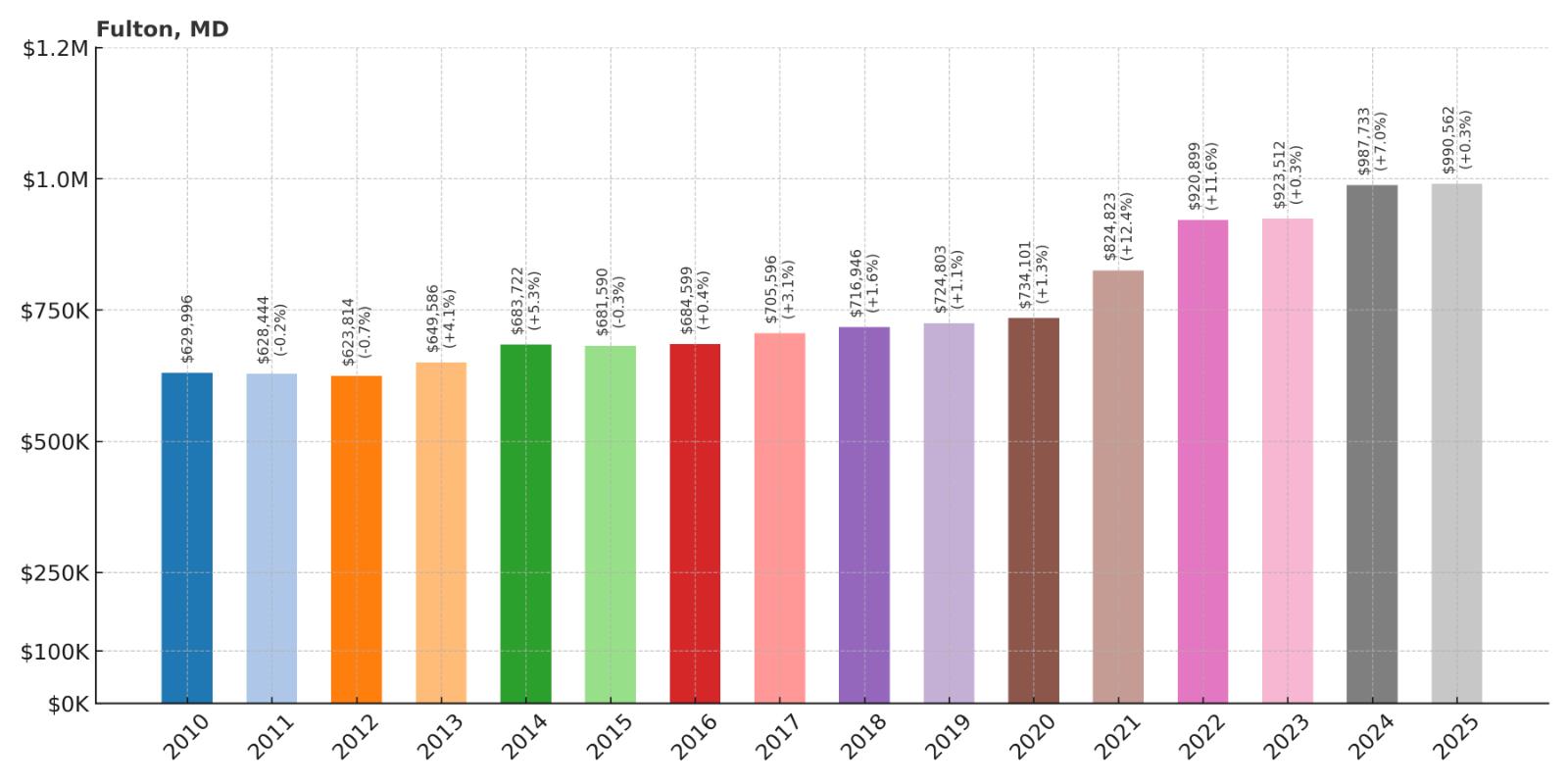
- 2010: $629,996
- 2011: $628,444
- 2012: $623,814
- 2013: $649,586
- 2014: $683,722
- 2015: $681,590
- 2016: $684,599
- 2017: $705,596
- 2018: $716,946
- 2019: $724,803
- 2020: $734,101
- 2021: $824,823
- 2022: $920,899
- 2023: $923,512
- 2024: $987,733
- 2025: $990,562
Fulton demonstrated consistent appreciation throughout the 15-year period, with particularly strong growth during 2021-2022. Values increased from $629,996 in 2010 to nearly $991,000 in 2025. The steady climb reflects the community’s appeal as a planned development with excellent schools and modern amenities in southern Howard County.
Why Fulton?

Why are people willing to pay so much to live here? What’s special about it?
Fulton attracts families seeking new construction homes in a master-planned community with excellent schools and modern amenities. The Maple Lawn development offers walkable neighborhoods, mixed-use design, and high-end retail and dining options. Residents value the combination of suburban convenience, architectural quality, and strong community amenities.
The area appeals to affluent professionals who want modern homes with premium finishes and community amenities. Planned development ensures consistent architectural standards and property maintenance. Howard County’s excellent schools and the community’s proximity to major employment centers in Columbia, Baltimore, and Washington D.C. support premium pricing.
How Fulton Rose to Prominence
Fulton remained largely agricultural until the late 20th century, consisting primarily of farms and rural estates in southern Howard County. The area’s transformation began in the 1990s when developers recognized the potential for upscale residential development between Columbia and the Washington D.C. metro area. The strategic location and access to major highways made it attractive for planned community development.
The signature Maple Lawn development, begun in the early 2000s, established Fulton as a premier destination for luxury planned community living. The mixed-use design incorporating residential, retail, and office space created a village-like atmosphere with modern amenities. The development’s success attracted additional upscale residential projects, establishing Fulton as one of Howard County’s most desirable addresses for families seeking new construction homes with community amenities.
3 Interesting Tidbits
- Maple Lawn Design – The signature development features neo-traditional architecture and walkable streets designed to recreate small-town charm with modern conveniences.
- New Urbanism – Fulton exemplifies new urbanism principles with mixed-use development, pedestrian-friendly design, and integrated retail and residential spaces.
- School Excellence – The community is served by some of Howard County’s highest-rated schools, including Fulton Elementary and Hammond High School, which consistently rank among Maryland’s best.
16. Glenelg – 55% Home Price Increase Since 2010
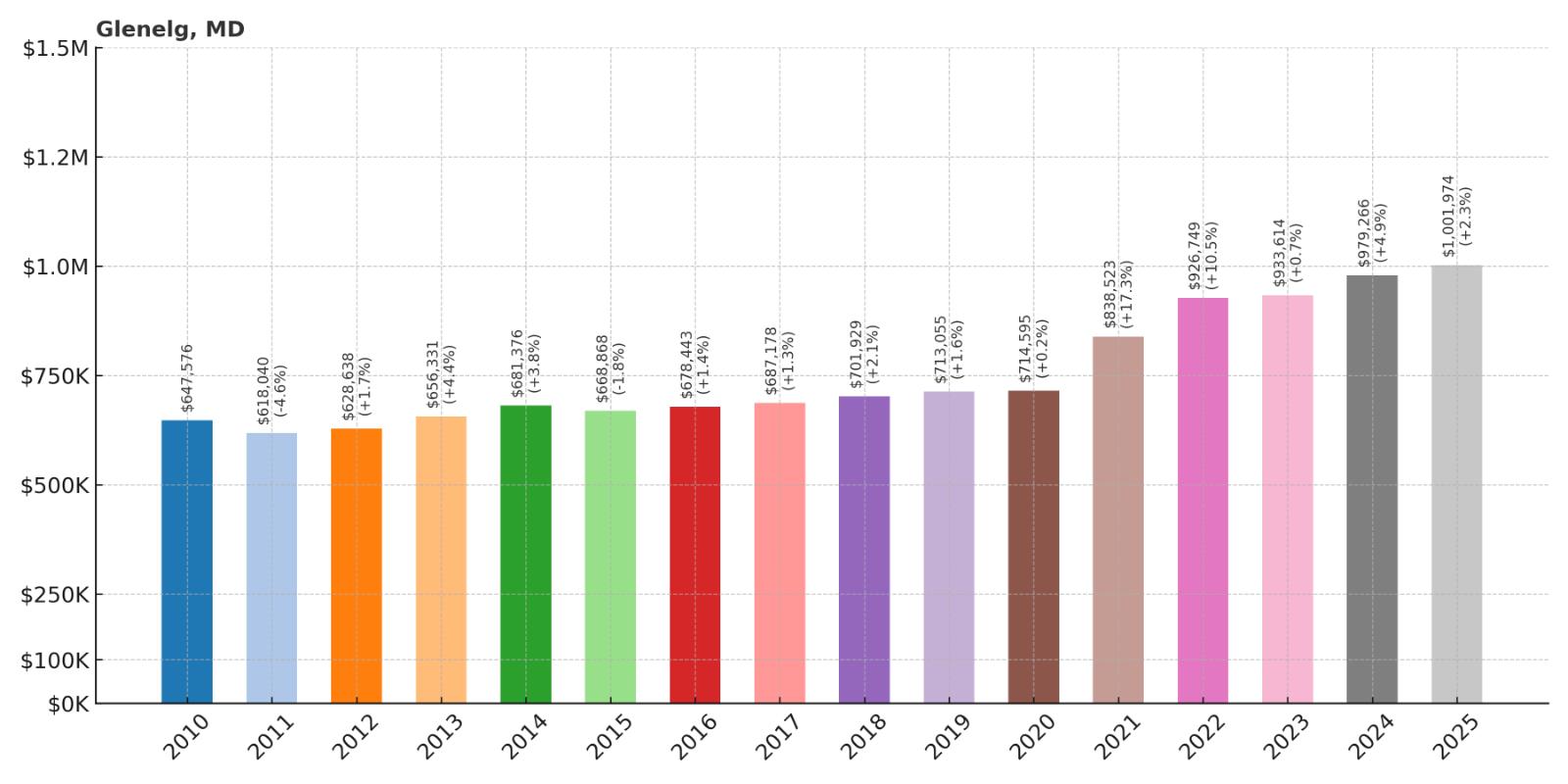
- 2010: $647,576
- 2011: $618,040
- 2012: $628,638
- 2013: $656,331
- 2014: $681,376
- 2015: $668,868
- 2016: $678,443
- 2017: $687,178
- 2018: $701,929
- 2019: $713,055
- 2020: $714,595
- 2021: $838,523
- 2022: $926,749
- 2023: $933,614
- 2024: $979,266
- 2025: $1,001,974
Glenelg showed steady growth through the 2010s before accelerating significantly during the pandemic era. Values jumped from $714,595 in 2020 to over $926,000 in 2022, with continued appreciation reaching over $1 million in 2025. The 55% increase since 2010 reflects the area’s transformation into a premier equestrian and rural residential community.
Why Glenelg?
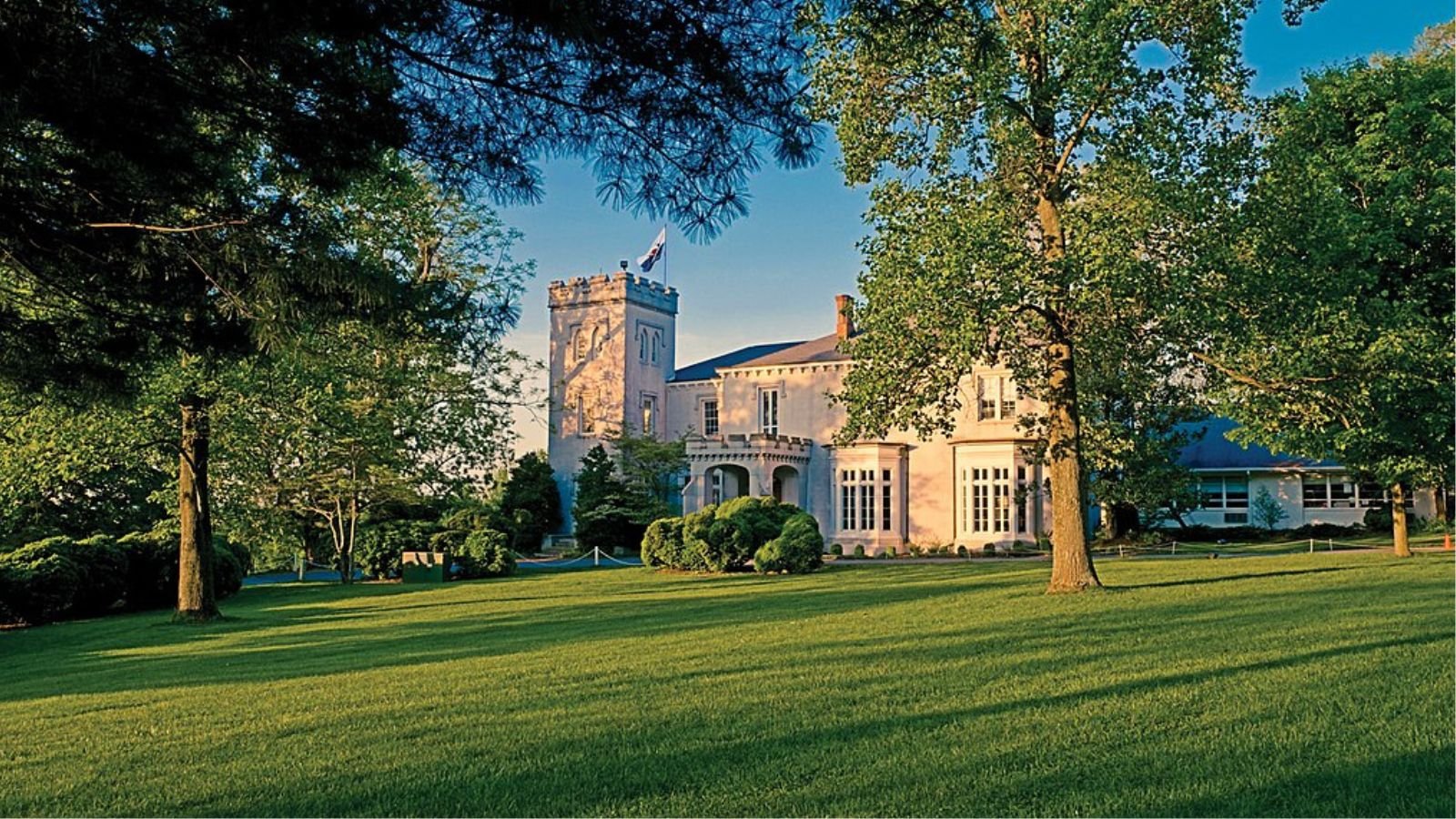
Why are people willing to pay so much to live here? What’s special about it?
Glenelg attracts affluent families seeking equestrian properties and rural estates within Howard County’s scenic countryside. Large lots, horse farms, and custom homes provide space for country lifestyle while maintaining access to excellent schools and urban amenities. Residents value the community’s commitment to preserving agricultural character and open space.
The area appeals to equestrian enthusiasts and professionals who want premium rural properties with reasonable commuting access to Baltimore and Washington D.C. Strong zoning requirements maintain large lot sizes and agricultural character. The combination of rural charm, excellent location, and limited housing inventory supports million-dollar property values.
How Glenelg Rose to Prominence
Named after a valley in Scotland, Glenelg was established in the mid-1700s as an agricultural community in western Howard County. The area developed around several mills along the Patapsco River branches, with local families operating grain and flour mills that served surrounding farms. The community remained largely agricultural through most of the 20th century, with dairy farms and grain operations dominating the landscape.
The transformation to an upscale residential area began in the 1970s as suburban development pressures reached western Howard County. However, rather than allowing typical subdivision development, the county maintained rural zoning that required large lots and preserved agricultural character. This attracted wealthy buyers seeking country estates and horse properties, establishing Glenelg as one of the county’s premier rural residential areas while maintaining its agricultural heritage and scenic character.
3 Interesting Tidbits
- Equestrian Center – Glenelg is home to numerous horse farms, riding schools, and equestrian events that maintain the community’s rural traditions and attract horse enthusiasts.
- Historic Mills – Several 18th and 19th-century mills along the Patapsco River branches remain as community landmarks and testament to the area’s agricultural heritage.
- Rural Preservation – Howard County’s rural zoning in Glenelg requires large lots and maintains agricultural character, supporting premium property values and quality of life.
15. Highland – 57% Home Price Increase Since 2010

- 2010: $654,050
- 2011: $652,080
- 2012: $627,933
- 2013: $661,703
- 2014: $699,974
- 2015: $697,918
- 2016: $694,025
- 2017: $703,012
- 2018: $719,020
- 2019: $732,910
- 2020: $734,677
- 2021: $852,351
- 2022: $940,148
- 2023: $944,366
- 2024: $1,015,254
- 2025: $1,024,780
Highland demonstrated steady appreciation through most periods before accelerating dramatically during 2021-2022. Values jumped from $734,677 in 2020 to over $940,000 in 2022, with continued growth exceeding $1 million by 2024. The 57% increase since 2010 reflects the community’s appeal for luxury rural living in Howard County.
Why Highland?
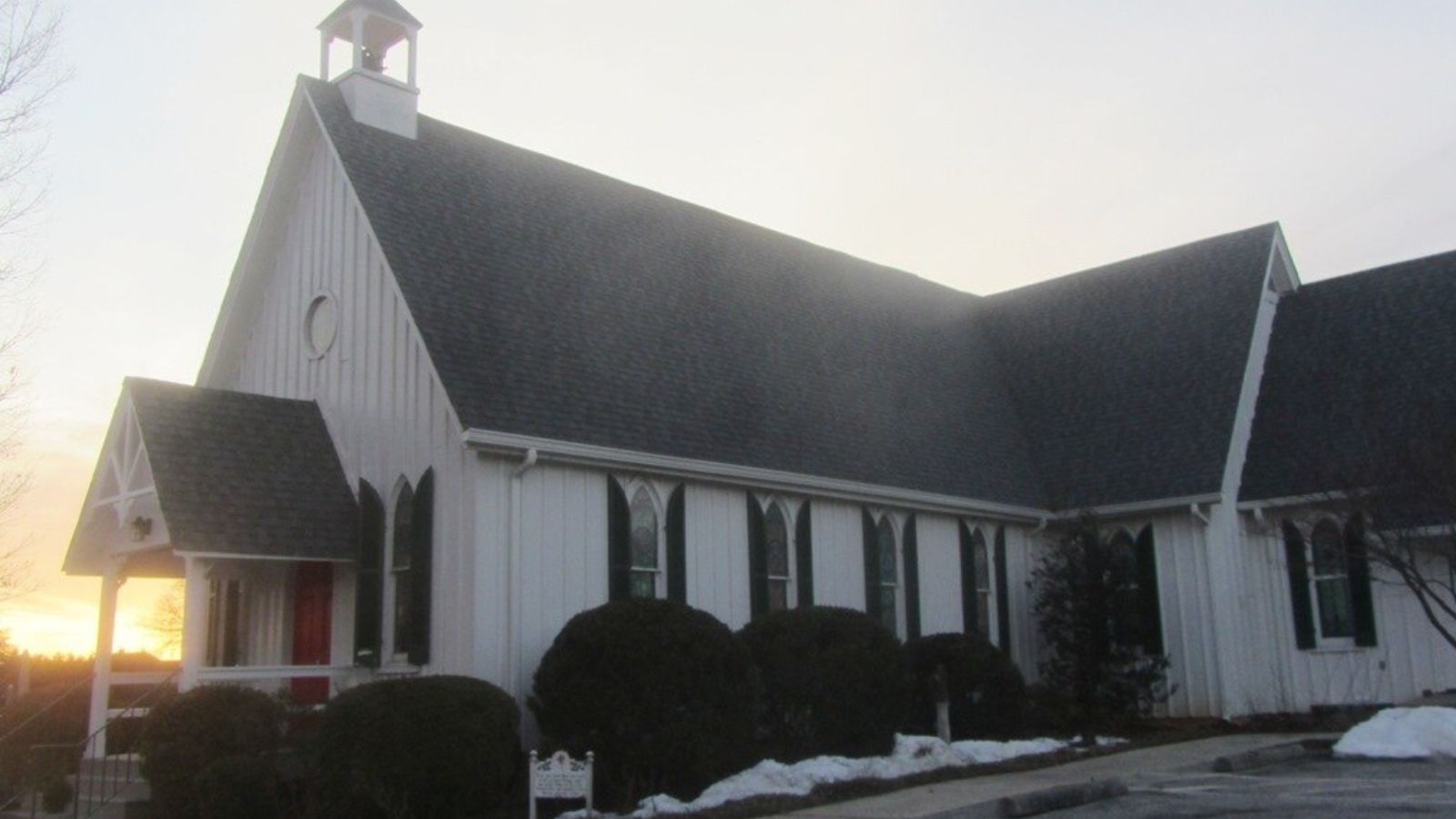
Why are people willing to pay so much to live here? What’s special about it?
Highland attracts affluent buyers seeking custom estates and rural properties with rolling hills and pastoral views. Large lots allow for luxury homes, outbuildings, and recreational amenities while maintaining Howard County’s excellent schools and services. Residents value the peaceful setting and strong property values supported by limited inventory and zoning restrictions.
The area appeals to professionals who can afford premium prices for country living with urban access to Baltimore and Washington D.C. Rural zoning maintains agricultural character and prevents overdevelopment. The combination of scenic beauty, privacy, and convenient location supports million-dollar property valuations.
How Highland Rose to Prominence
Highland developed as a farming community in the rolling hills of western Howard County during the 18th and 19th centuries. The area’s elevated terrain and fertile soils made it ideal for diversified agriculture, with local families operating grain farms, dairy operations, and livestock raising. Several small mills along local streams processed grain for area farmers and provided local employment.
The transition to upscale residential development began in the 1980s as Howard County’s growth reached the western areas. However, careful planning maintained rural character through large lot zoning and agricultural preservation. The scenic terrain and rural atmosphere attracted wealthy buyers seeking country estates, transforming Highland into one of the county’s most exclusive residential areas while preserving its agricultural landscape and scenic character.
3 Interesting Tidbits
- Scenic Terrain – Highland’s rolling hills and elevated locations provide some of Howard County’s most scenic rural views and attractive building sites for custom homes.
- Agricultural Heritage – The area maintains active farms and agricultural operations alongside residential development, preserving its rural character and heritage.
- Rural Zoning – Large lot requirements and rural zoning preserve open space and agricultural character while supporting premium property values for custom estates.
14. Darnestown – 40% Home Price Increase Since 2010
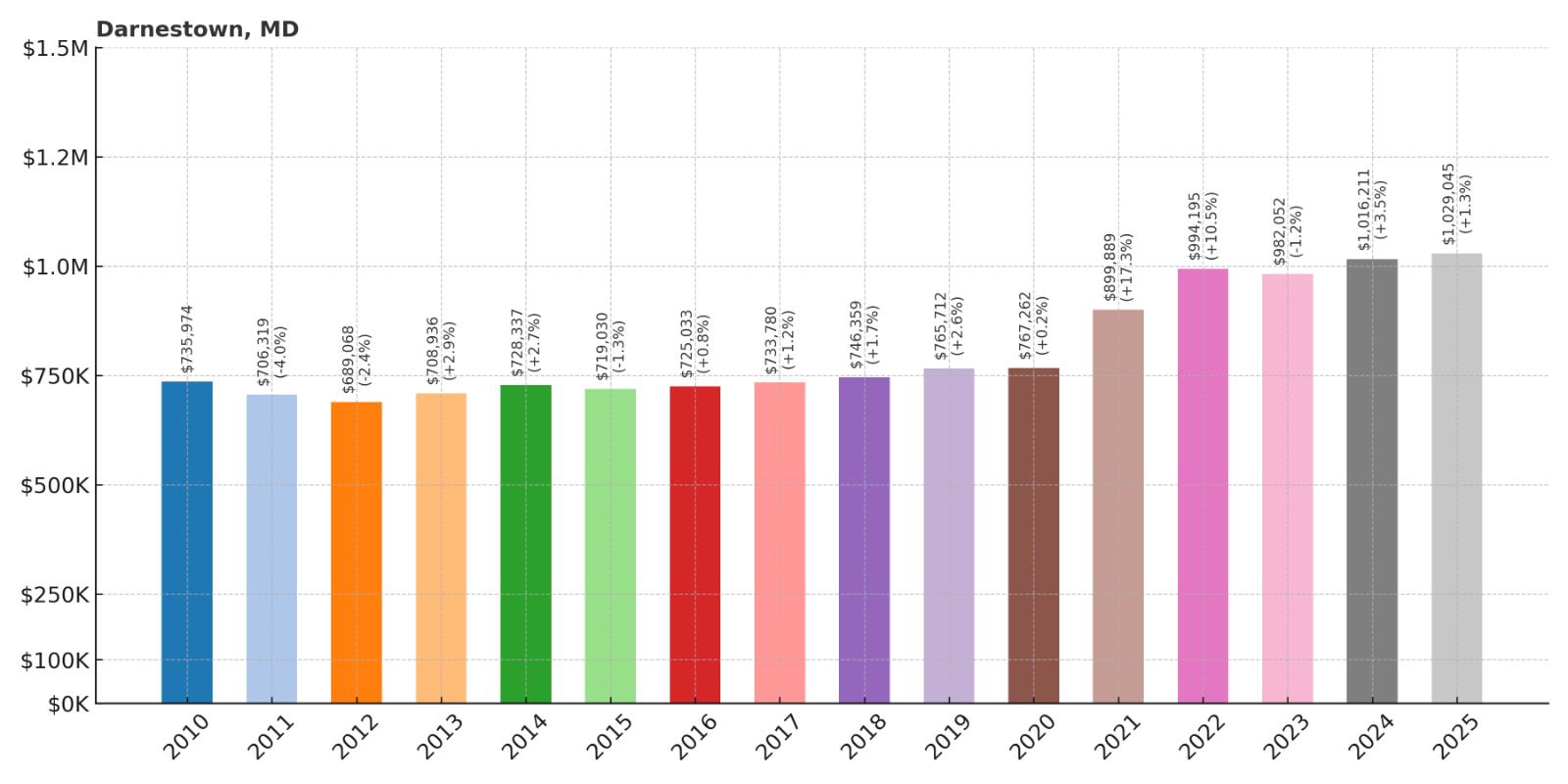
- 2010: $735,974
- 2011: $706,319
- 2012: $689,068
- 2013: $708,936
- 2014: $728,337
- 2015: $719,030
- 2016: $725,033
- 2017: $733,780
- 2018: $746,359
- 2019: $765,712
- 2020: $767,262
- 2021: $899,889
- 2022: $994,195
- 2023: $982,052
- 2024: $1,016,211
- 2025: $1,029,045
Starting from a higher baseline of $735,974 in 2010, Darnestown showed steady but modest growth through the 2010s. The community experienced significant acceleration during 2021-2022, with values jumping from $767,262 to nearly $995,000. Current values exceeding $1 million reflect the area’s established position as a premier Montgomery County location.
Why Darnestown?

Why are people willing to pay so much to live here? What’s special about it?
Darnestown attracts affluent families seeking large estates and custom homes within Montgomery County’s rural areas. The community offers substantial lots, often 2-5 acres, allowing for luxury homes with privacy and space for amenities. Residents value access to excellent Montgomery County schools while maintaining a country atmosphere with urban convenience.
The area appeals to successful professionals who want premium properties with room for recreation, entertaining, and family activities. Strong zoning maintains lot sizes and prevents overdevelopment while supporting million-dollar home values. The combination of rural character, excellent schools, and proximity to Washington D.C. creates sustained demand for available properties.
How Darnestown Rose to Prominence
Named after William Darne, who established a tavern and inn in the 1700s along the old Frederick road, Darnestown developed as a crossroads community serving travelers between Washington and Frederick. The village remained small and agriculturally focused through most of its history, with local families operating farms and providing services to the surrounding rural area.
The transformation to an upscale residential community began in the 1960s as Montgomery County’s suburban growth reached the western areas. However, rather than allowing typical suburban development, the county maintained large lot zoning that preserved rural character. This attracted wealthy buyers seeking country estates with reasonable access to Washington D.C., establishing Darnestown as one of the county’s premier addresses for luxury rural living while maintaining its historic identity.
3 Interesting Tidbits
- Historic Tavern – Darne’s Inn, established in the 1700s, served as a crucial stop for travelers on the road between Washington and Frederick, helping establish the community’s identity.
- Agricultural Reserve – Much of Darnestown lies within Montgomery County’s Agricultural Reserve, which preserves rural character and maintains large lot sizes for residential development.
- Seneca Creek Park – The nearby 6,300-acre state park provides hiking, fishing, and outdoor recreation that enhances the community’s appeal to nature-loving residents.
13. West Friendship – 61% Home Price Increase Since 2010
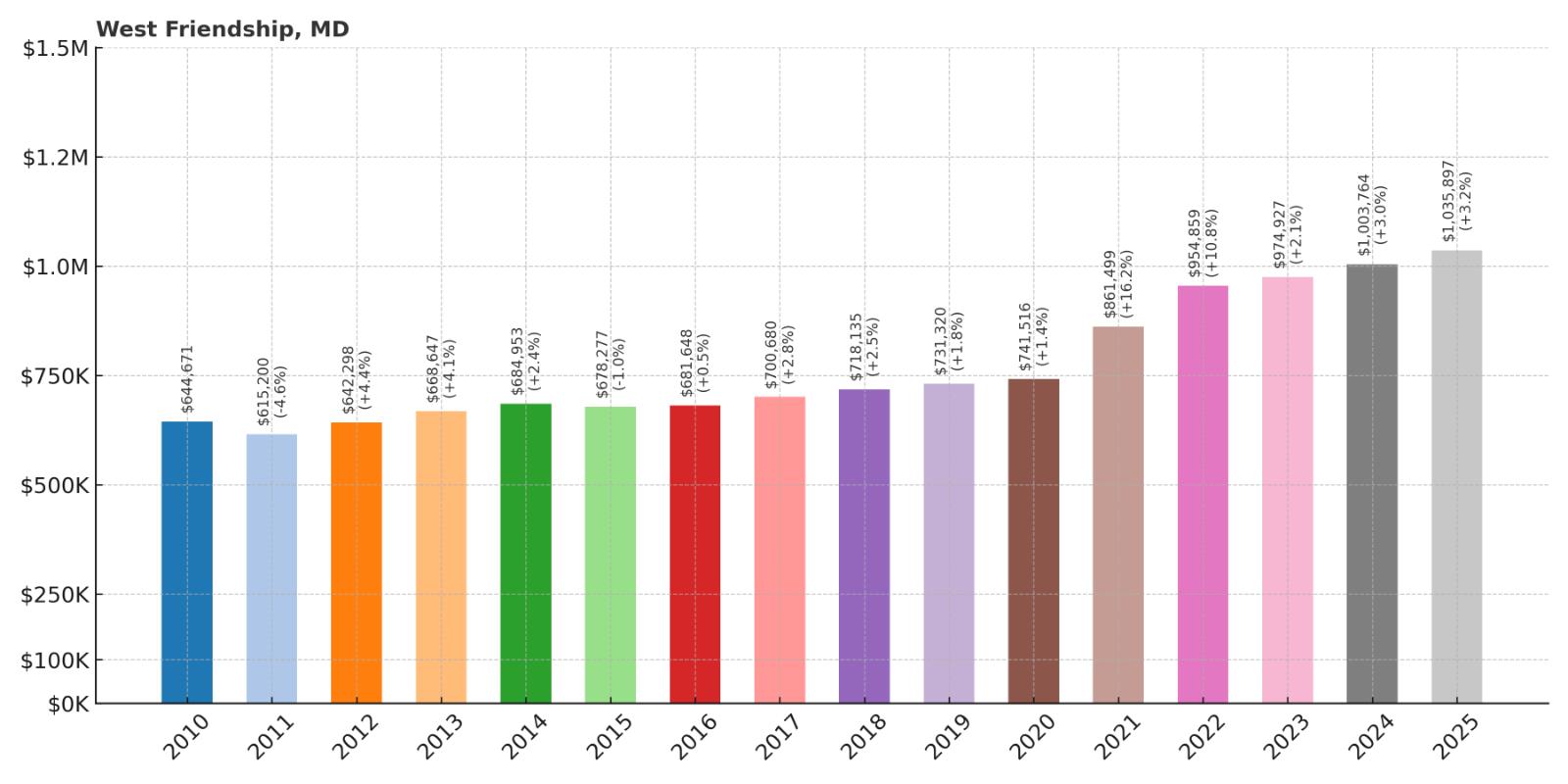
- 2010: $644,671
- 2011: $615,200
- 2012: $642,298
- 2013: $668,647
- 2014: $684,953
- 2015: $678,277
- 2016: $681,648
- 2017: $700,680
- 2018: $718,135
- 2019: $731,320
- 2020: $741,516
- 2021: $861,499
- 2022: $954,859
- 2023: $974,927
- 2024: $1,003,764
- 2025: $1,035,897
West Friendship showed steady growth through the 2010s before experiencing dramatic acceleration during the pandemic era. Values jumped from $741,516 in 2020 to nearly $955,000 in 2022, with continued appreciation exceeding $1 million by 2024. The 61% increase since 2010 reflects strong demand for rural properties in Howard County’s desirable western areas.
Why West Friendship?
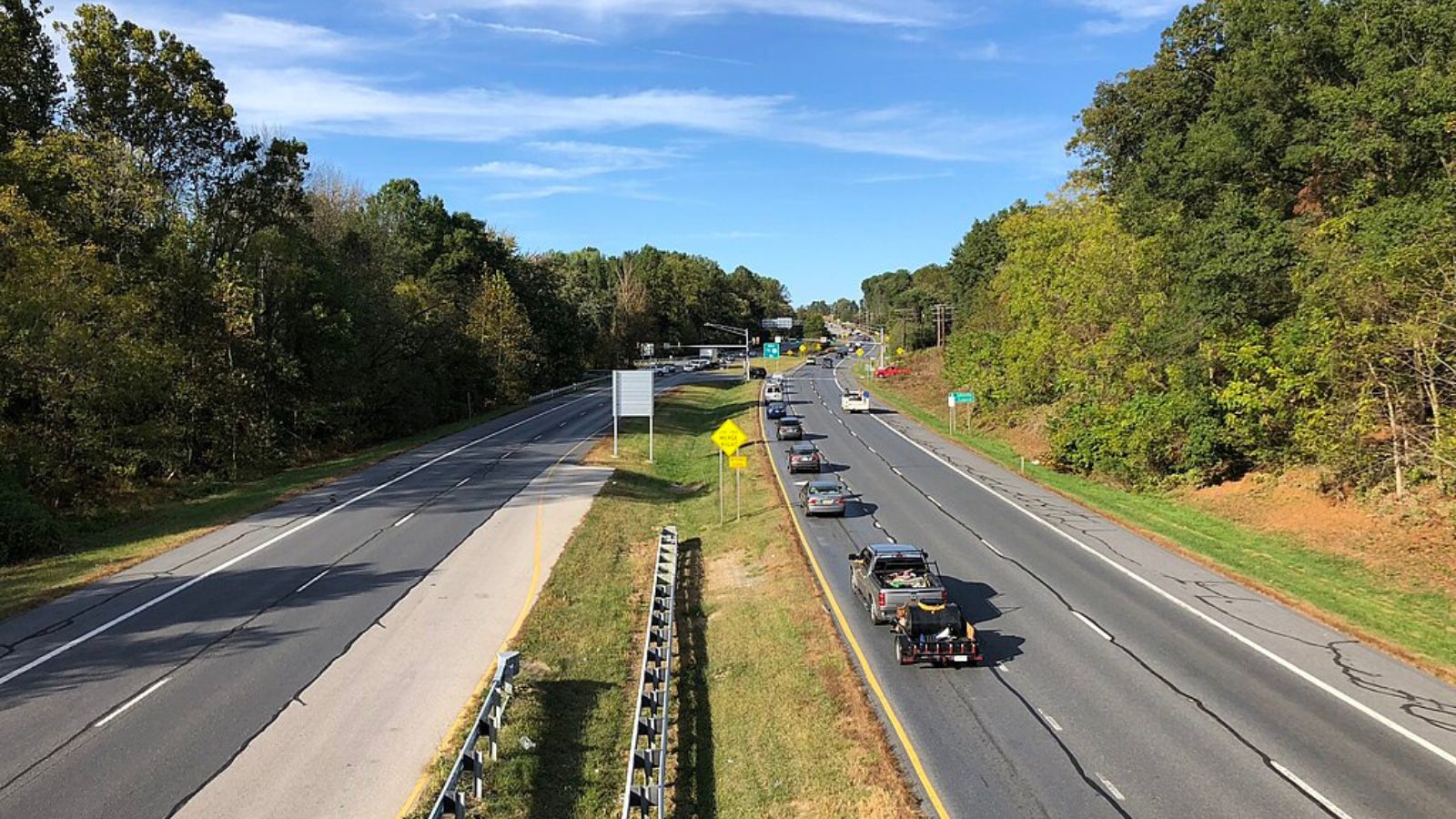
Why are people willing to pay so much to live here? What’s special about it?
West Friendship attracts affluent families seeking rural estates and equestrian properties within Howard County’s scenic countryside. Large lots provide space for custom homes, horse facilities, and recreational amenities while maintaining access to excellent schools and county services. Residents value the peaceful setting and strong community connections fostered by shared rural interests.
The area appeals to successful professionals and equestrian enthusiasts who want premium rural properties with reasonable access to Baltimore and Washington D.C. Strong zoning requirements maintain agricultural character and large lot sizes. The combination of rural charm, excellent location, and limited housing inventory supports million-dollar property valuations.
How West Friendship Rose to Prominence
Established in the early 1800s as a Quaker farming community, West Friendship developed around agricultural activities and the religious meetings that gave the area its name. The community remained largely rural through most of the 20th century, with local families operating dairy farms, grain operations, and other agricultural enterprises that defined the area’s character and economy.
The transformation to an upscale residential area began in the 1970s as Howard County’s suburban growth reached the western regions. However, careful planning maintained rural character through large lot zoning and agricultural preservation programs. The scenic countryside and proximity to major employment centers attracted wealthy buyers seeking country estates, establishing West Friendship as one of the county’s most exclusive rural residential areas.
3 Interesting Tidbits
- Quaker Heritage – The community was founded by Quakers in the early 1800s, with the West Friendship Meeting House serving as a spiritual and social center that influenced the area’s development.
- Agricultural Preservation – Howard County’s rural zoning and agricultural preservation programs help maintain the area’s farming character alongside upscale residential development.
- Equestrian Community – The area is home to numerous horse farms, riding schools, and equestrian events that preserve rural traditions and attract horse enthusiasts from across the region.
12. Clarksville – 69% Home Price Increase Since 2010

- 2010: $620,065
- 2011: $621,991
- 2012: $627,891
- 2013: $669,637
- 2014: $708,840
- 2015: $701,902
- 2016: $708,400
- 2017: $723,853
- 2018: $732,478
- 2019: $745,529
- 2020: $748,497
- 2021: $842,974
- 2022: $942,557
- 2023: $956,836
- 2024: $1,027,893
- 2025: $1,045,376
Clarksville demonstrated consistent growth throughout the 15-year period, with particularly strong performance during 2021-2024. Values increased from $620,065 in 2010 to over $1 million by 2024. The 69% appreciation reflects the community’s evolution from a rural crossroads to one of central Maryland’s most desirable addresses.
Why Clarksville?

Why are people willing to pay so much to live here? What’s special about it?
Clarksville attracts affluent families seeking upscale suburban living with excellent schools and modern amenities. The community combines luxury neighborhoods with preserved countryside, offering diverse housing options from townhomes to custom estates. Residents value the convenient access to shopping, dining, and recreation while maintaining a family-friendly atmosphere.
The area appeals to successful professionals who want premium properties with access to top-rated Howard County schools and recreational facilities. The River Hill Village Center provides upscale shopping and dining within walking distance of many neighborhoods. Strong community organizations and low crime rates support property values and quality of life.
How Clarksville Rose to Prominence
Originally known as Clarks Station, the community developed in the mid-1800s as a stop along the B&O Railroad between Baltimore and Washington. The village served local farming areas with a grain elevator, general store, and post office, remaining a small agricultural center through most of the 20th century. The surrounding countryside was dominated by dairy farms and grain operations.
The transformation began in the 1980s when Howard County’s planned growth reached the Route 108 corridor. The development of Columbia and other planned communities created demand for additional upscale residential areas. Clarksville’s strategic location between Columbia and Damascus, combined with excellent transportation access, made it ideal for luxury suburban development that attracted affluent families seeking modern amenities with country club atmosphere.
3 Interesting Tidbits
- Railroad Heritage – The historic Clarksville train station, built in 1902, now houses community offices and serves as a reminder of the town’s transportation legacy.
- Ten Oaks Ballroom – This elegant venue, built in a restored dairy barn, hosts weddings and events while preserving the area’s agricultural heritage.
- Village Center – River Hill Village Center provides upscale shopping, dining, and services in a walkable environment designed to recreate small-town charm.
11. Glenwood – 54% Home Price Increase Since 2010
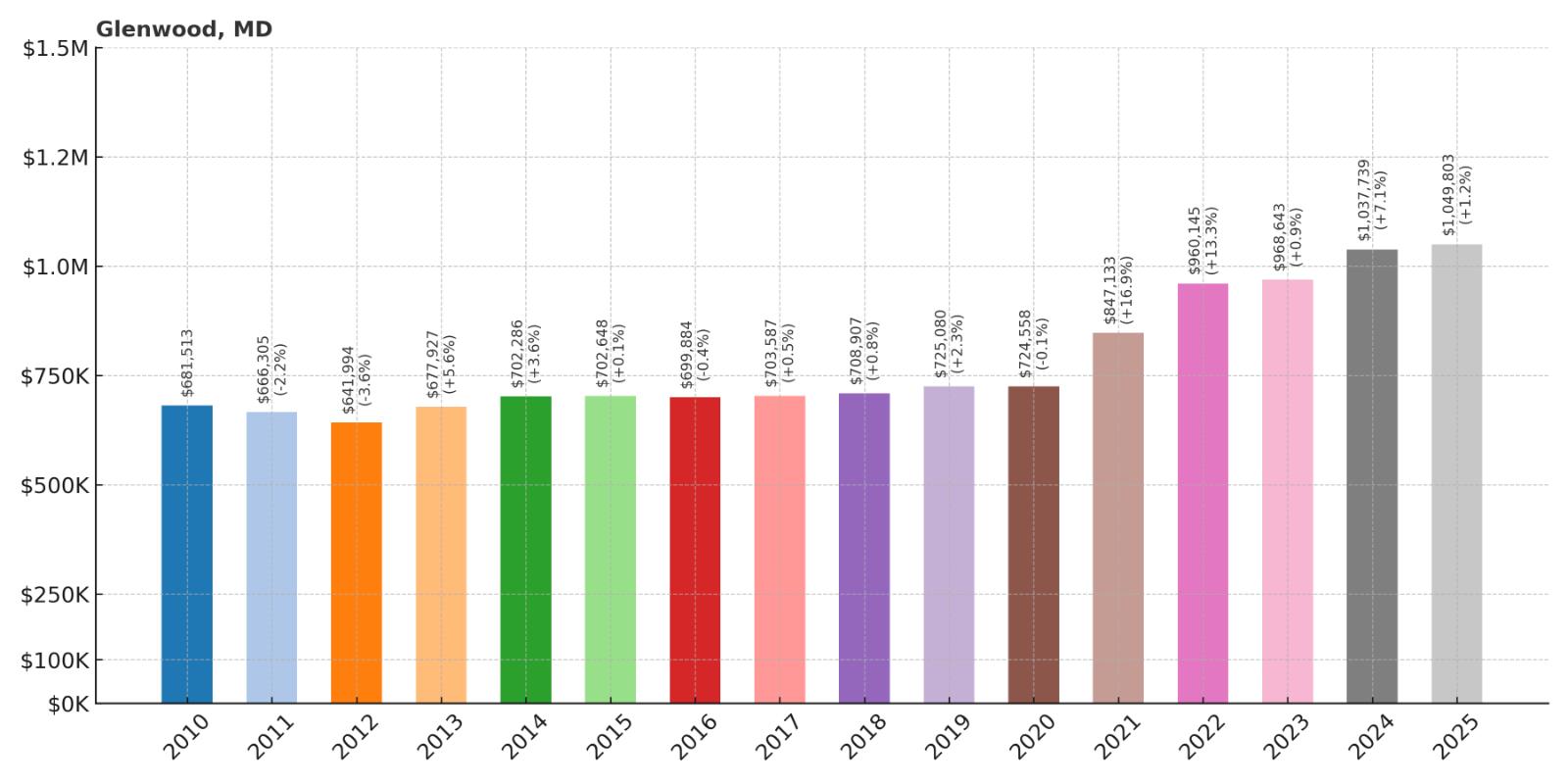
- 2010: $681,513
- 2011: $666,305
- 2012: $641,994
- 2013: $677,927
- 2014: $702,286
- 2015: $702,648
- 2016: $699,884
- 2017: $703,587
- 2018: $708,907
- 2019: $725,080
- 2020: $724,558
- 2021: $847,133
- 2022: $960,145
- 2023: $968,643
- 2024: $1,037,739
- 2025: $1,049,803
Starting from a higher baseline, Glenwood showed steady appreciation through most periods before accelerating significantly during 2021-2022. Values jumped from $724,558 in 2020 to over $960,000 in 2022, with continued growth exceeding $1 million. The 54% increase since 2010 reflects the area’s appeal for luxury rural living in Howard County.
Why Glenwood?

Why are people willing to pay so much to live here? What’s special about it?
Glenwood attracts buyers seeking custom estates and luxury rural properties in Howard County’s scenic western areas. Large lots provide space for high-end homes, recreational amenities, and privacy while maintaining access to excellent schools and county services. Residents value the combination of country atmosphere and proximity to major employment centers.
The area appeals to affluent professionals who want premium rural properties with convenient access to Baltimore and Washington D.C. Strong zoning requirements maintain rural character and large lot sizes. The scenic terrain and agricultural preservation programs support million-dollar property values and quality of life.
How Glenwood Rose to Prominence
Glenwood developed as a small farming community in the rolling hills of western Howard County during the 18th and 19th centuries. The area’s name reflects its location among wooded valleys and streams that provided water power for local mills. Several grain and flour mills served surrounding farms, while the countryside remained largely agricultural through the mid-20th century.
The transition to upscale residential development began in the 1980s as Howard County’s growth reached the western areas. However, careful planning preserved rural character through large lot zoning and agricultural preservation. The combination of scenic beauty, rural atmosphere, and strategic location attracted wealthy buyers seeking country estates, establishing Glenwood as one of the county’s most exclusive residential areas.
3 Interesting Tidbits
- Mill Heritage – Historic mills along local streams processed grain for area farmers and provided the industrial foundation for the early community’s development.
- Scenic Beauty – Glenwood’s rolling hills, mature forests, and pastoral views make it one of Howard County’s most picturesque rural residential areas.
- Agricultural Preservation – County programs preserve working farms and rural character alongside luxury residential development, maintaining the area’s countryside appeal.
10. Garrett Park – 62% Home Price Increase Since 2010
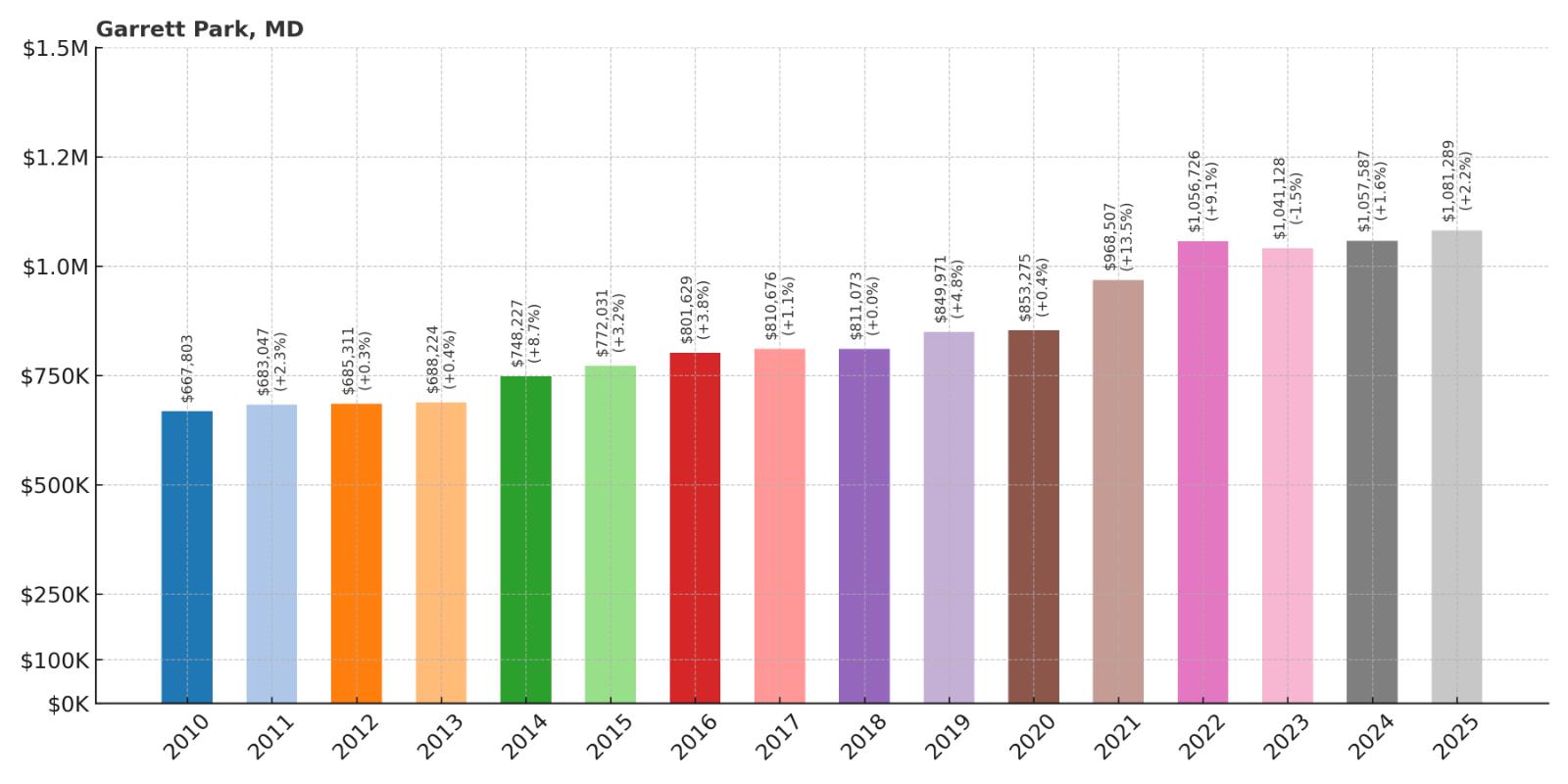
- 2010: $667,803
- 2011: $683,047
- 2012: $685,311
- 2013: $688,224
- 2014: $748,227
- 2015: $772,031
- 2016: $801,629
- 2017: $810,676
- 2018: $811,073
- 2019: $849,971
- 2020: $853,275
- 2021: $968,507
- 2022: $1,056,726
- 2023: $1,041,128
- 2024: $1,057,587
- 2025: $1,081,289
Garrett Park showed steady appreciation throughout the period, crossing the million-dollar threshold in 2022. Values have continued climbing to over $1.08 million in 2025. The 62% increase since 2010 reflects the town’s unique character as an incorporated arboretum community with Victorian architecture and walkable design.
Why Garrett Park?

Why are people willing to pay so much to live here? What’s special about it?
Garrett Park attracts buyers seeking historic charm and small-town atmosphere within walking distance of Metro stations. The incorporated town is designated as an arboretum, with tree-lined streets and Victorian architecture creating exceptional character. Residents value the walkable community, active civic engagement, and preservation of historic features.
The area appeals to professionals who want unique housing with convenient Metro access to Washington D.C. Strong municipal services and community involvement maintain property values and neighborhood quality. The combination of historic preservation, environmental stewardship, and urban convenience creates sustained demand for the limited housing inventory.
How Garrett Park Rose to Prominence
Founded in 1898 as a planned suburban community, Garrett Park was designed to provide country living with railroad access to Washington D.C. The development was named after John W. Garrett, president of the B&O Railroad, and featured wide, tree-lined streets, large lots, and architectural restrictions to ensure quality. The Victorian-era homes and community design attracted middle-class professionals seeking suburban refuge from city life.
The town incorporated in 1898 and has maintained local control over development and municipal services ever since. In 1964, the community was designated as an arboretum, reflecting its commitment to urban forestry and environmental preservation. This unique status, combined with the preserved Victorian architecture and walkable design, has made Garrett Park one of the region’s most distinctive and desirable small towns.
3 Interesting Tidbits
- Arboretum Status – Garrett Park is the only incorporated town in the United States designated as an arboretum, reflecting its commitment to tree preservation and urban forestry.
- Nuclear-Free Zone – The town declared itself a nuclear-free zone in 1982, prohibiting nuclear weapons or waste within its boundaries, reflecting its progressive values.
- Victorian Architecture – The town features one of the region’s best-preserved collections of Victorian-era homes, with many original structures maintained in excellent condition.
9. Royal Oak – 68% Home Price Increase Since 2010
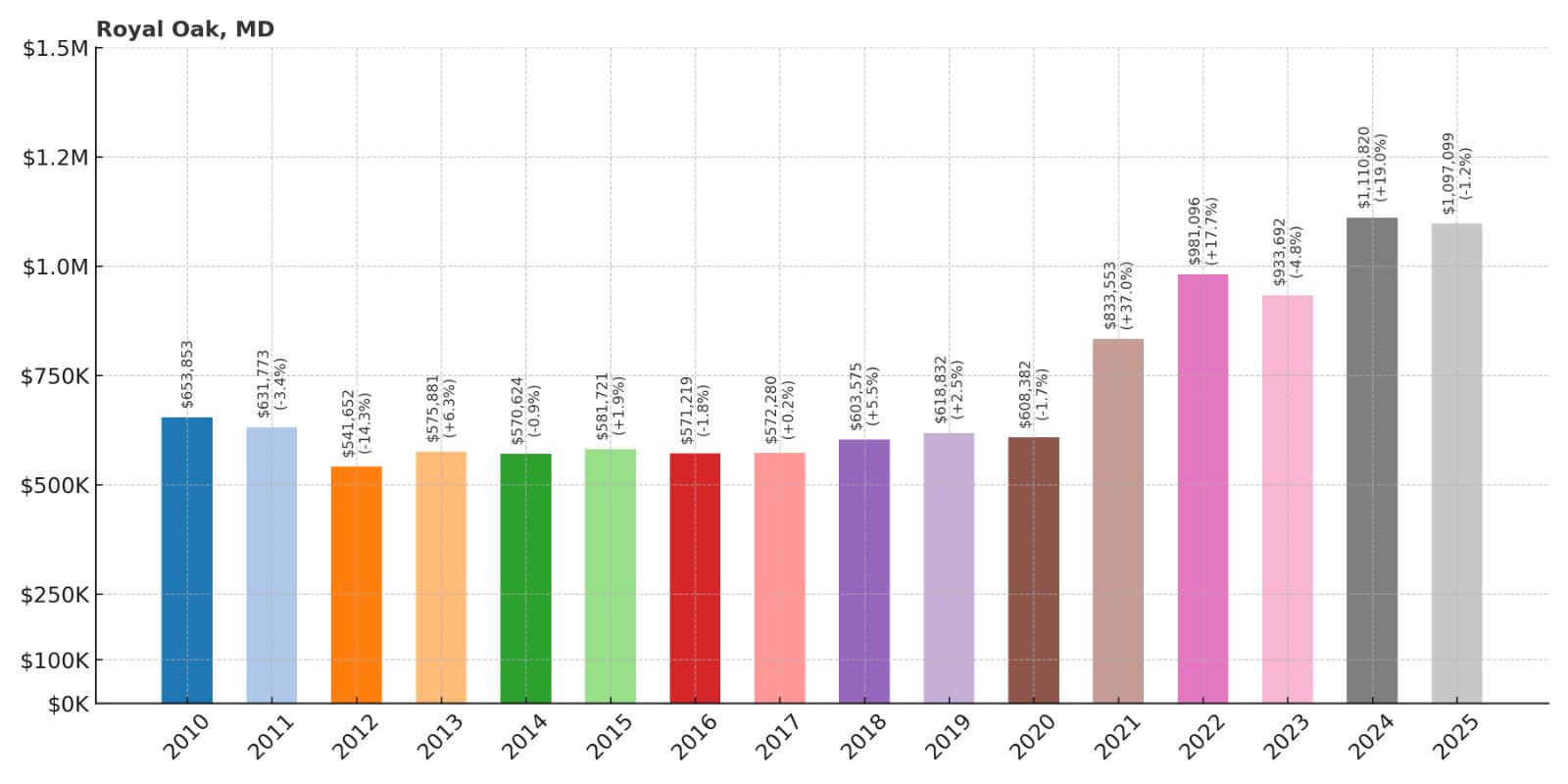
- 2010: $653,853
- 2011: $631,773
- 2012: $541,652
- 2013: $575,881
- 2014: $570,624
- 2015: $581,721
- 2016: $571,219
- 2017: $572,280
- 2018: $603,575
- 2019: $618,832
- 2020: $608,382
- 2021: $833,553
- 2022: $981,096
- 2023: $933,692
- 2024: $1,110,820
- 2025: $1,097,099
Royal Oak experienced dramatic volatility, with values dropping to $541,652 in 2012 before recovering. The most remarkable growth occurred from 2020-2024, when prices surged from $608,382 to over $1.1 million. The 68% increase since 2010 understates the community’s recent transformation into a premier Eastern Shore waterfront destination.
Why Royal Oak?
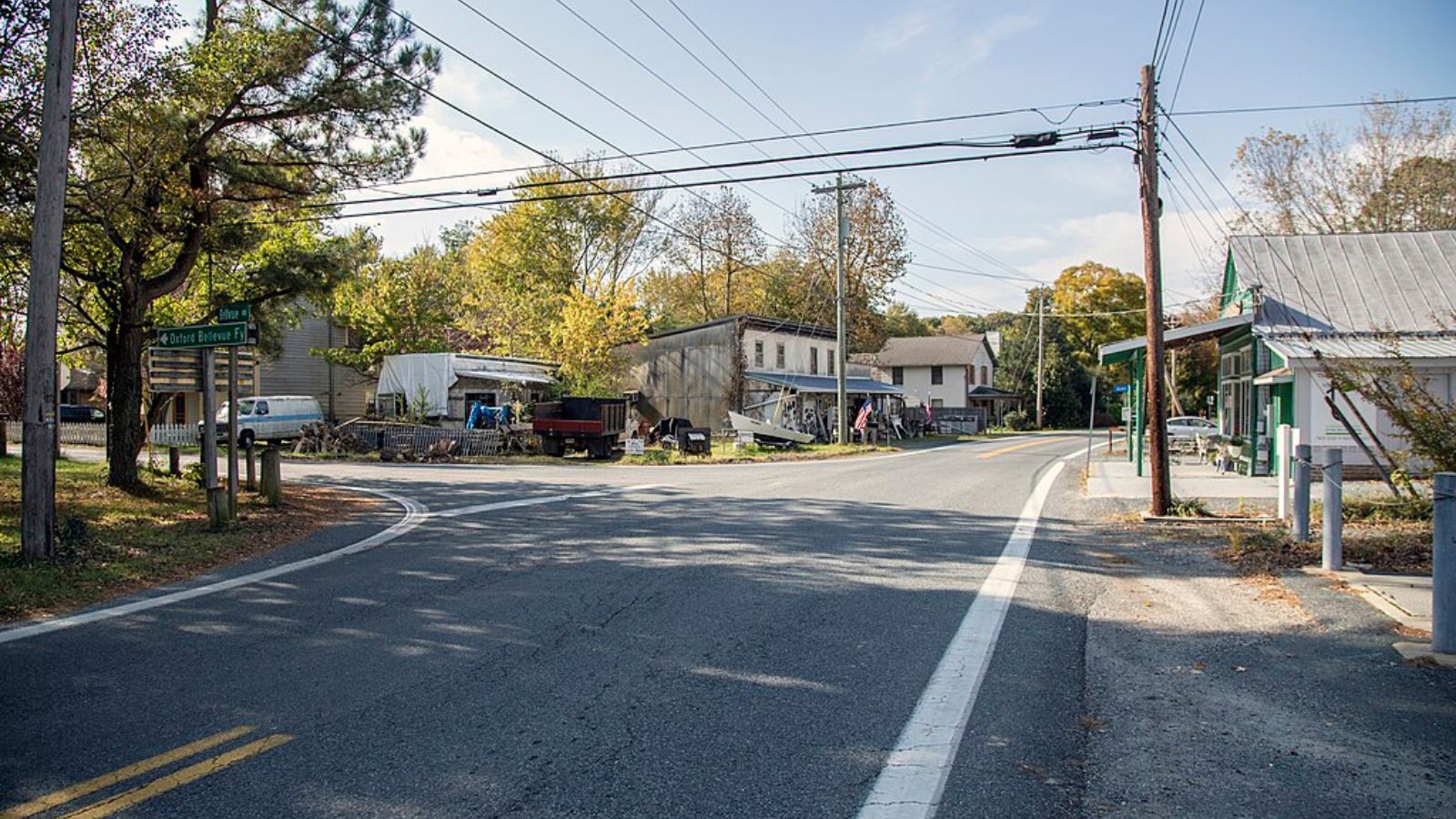
Why are people willing to pay so much to live here? What’s special about it?
Royal Oak attracts buyers seeking waterfront lifestyle in a charming Eastern Shore village with deep-water access and maritime heritage. The Tred Avon River location provides excellent boating, fishing, and water recreation opportunities. Residents value the small-town atmosphere, waterfront dining, and proximity to St. Michaels and Easton cultural amenities.
The community appeals to affluent retirees and second-home owners from metropolitan areas seeking peaceful waterfront retreat. Limited development and historic character preservation support premium property values. The combination of water access, rural charm, and recreational opportunities creates strong demand for available waterfront properties.
How Royal Oak Rose to Prominence
Established in the early 1700s as a small farming and fishing village on Talbot County’s Tred Avon River, Royal Oak served the local agricultural economy and bay maritime activities. The community remained small and rural through most of its history, with residents combining farming with waterman occupations like oystering, crabbing, and fishing on the Chesapeake Bay.
The transformation to a desirable waterfront community accelerated in recent decades as urban professionals discovered the Eastern Shore’s appeal. Improved transportation access and the growth of St. Michaels as a tourist destination increased Royal Oak’s visibility. The community’s authentic maritime character, combined with excellent water access and proximity to cultural amenities, attracted affluent buyers seeking waterfront lifestyle, driving dramatic property value increases.
3 Interesting Tidbits
- Ferry Heritage – Royal Oak was historically connected to the Western Shore by ferry services that transported passengers, vehicles, and goods across the Chesapeake Bay.
- Maritime Village – The community maintains its authentic waterman character with working boats, seafood houses, and traditional Chesapeake Bay architecture.
- Tred Avon Ferry – The historic ferry connecting Royal Oak to Bellevue continues to operate seasonally, preserving the area’s maritime transportation heritage.
8. Dayton – 56% Home Price Increase Since 2010
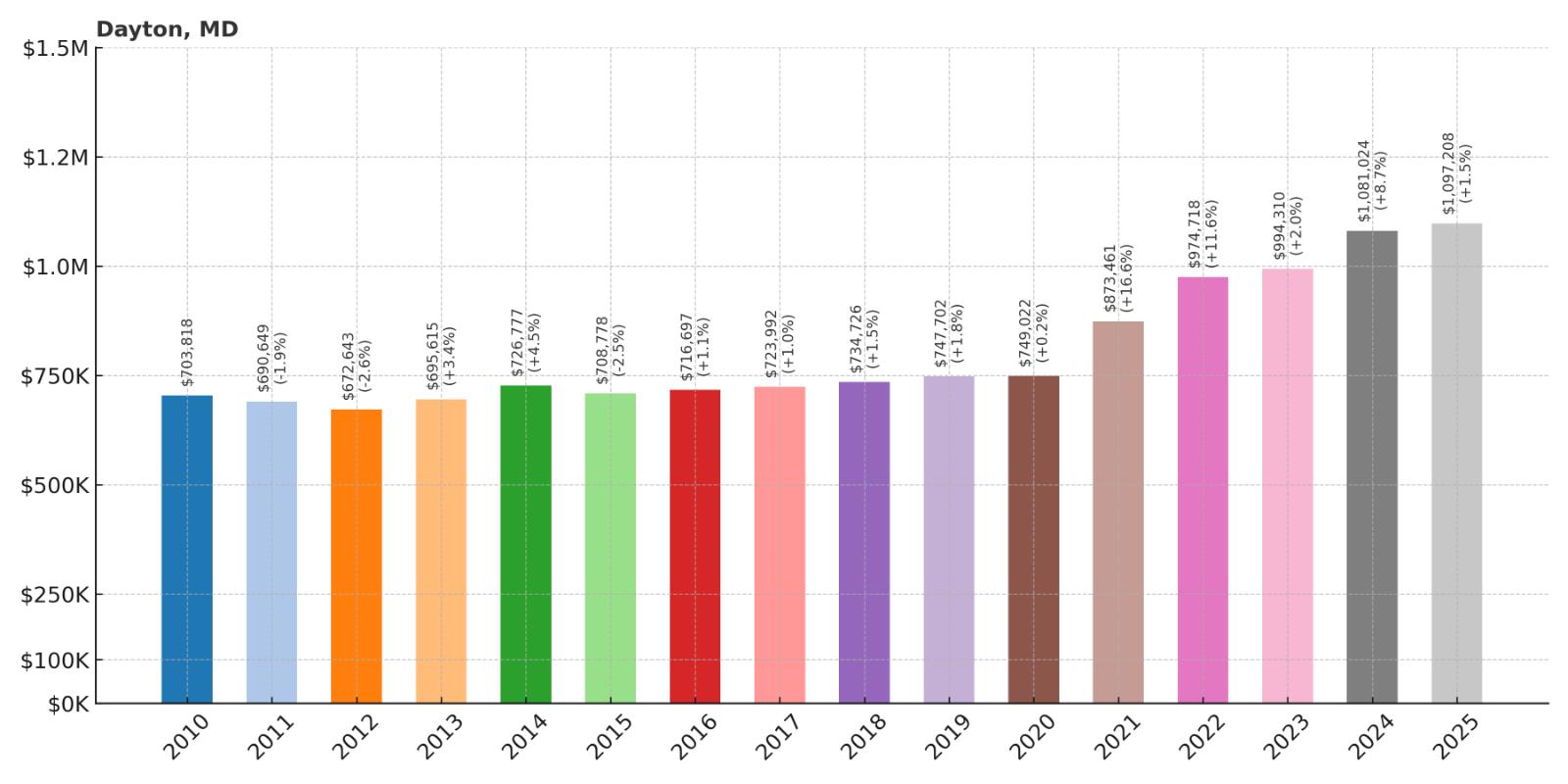
- 2010: $703,818
- 2011: $690,649
- 2012: $672,643
- 2013: $695,615
- 2014: $726,777
- 2015: $708,778
- 2016: $716,697
- 2017: $723,992
- 2018: $734,726
- 2019: $747,702
- 2020: $749,022
- 2021: $873,461
- 2022: $974,718
- 2023: $994,310
- 2024: $1,081,024
- 2025: $1,097,208
Starting from a higher baseline of over $700,000 in 2010, Dayton showed steady growth before accelerating during the pandemic era. Values jumped from $749,022 in 2020 to nearly $975,000 in 2022, with continued appreciation exceeding $1.09 million in 2025. The consistent growth reflects strong demand for rural properties in Howard County’s desirable locations.
Why Dayton?

Why are people willing to pay so much to live here? What’s special about it?
Dayton attracts affluent families seeking rural estates and luxury properties within Howard County’s scenic countryside. Large lots provide space for custom homes, recreational amenities, and privacy while maintaining access to excellent schools and county services. Residents value the peaceful rural setting and proximity to major employment centers in Baltimore and Washington D.C.
The area appeals to successful professionals who want premium rural properties with room for horses, gardens, and outdoor recreation. Strong zoning requirements maintain agricultural character and large lot sizes. The combination of rural charm, convenient location, and limited housing inventory supports million-dollar property valuations.
How Dayton Rose to Prominence
Named after the Dayton family who settled in the area in the early 1800s, the community developed as a small agricultural village serving local farming operations. The area remained largely rural through most of the 20th century, with local families operating dairy farms, grain operations, and other agricultural enterprises in the rolling countryside of western Howard County.
The transformation to an upscale residential area began in the 1980s as Howard County’s suburban growth reached the western regions. However, careful county planning maintained rural character through large lot zoning and agricultural preservation programs. The scenic countryside and strategic location attracted wealthy buyers seeking country estates, establishing Dayton as one of the county’s most exclusive rural residential areas while preserving its agricultural heritage.
3 Interesting Tidbits
- Agricultural Heritage – The area maintains working farms and agricultural operations alongside luxury residential development, preserving its rural character and heritage.
- Triadelphia Reservoir – The nearby reservoir provides water recreation opportunities and scenic views that enhance the area’s appeal to outdoor enthusiasts.
- Rural Preservation – Howard County’s rural zoning and agricultural preservation programs help maintain large lot sizes and countryside character while supporting premium property values.
7. Bethesda – 49% Home Price Increase Since 2010

- 2010: $765,000
- 2011: $761,441
- 2012: $736,100
- 2013: $776,136
- 2014: $820,851
- 2015: $832,707
- 2016: $840,702
- 2017: $853,503
- 2018: $864,259
- 2019: $877,177
- 2020: $878,961
- 2021: $1,014,222
- 2022: $1,099,782
- 2023: $1,079,021
- 2024: $1,113,047
- 2025: $1,137,069
Starting from a substantial baseline of $765,000 in 2010, Bethesda showed steady appreciation before crossing into seven-figure territory in 2021. Values have continued climbing to over $1.13 million in 2025. The 49% increase reflects the community’s established status as one of the Washington metro area’s premier suburban addresses.
Why Bethesda?

Why are people willing to pay so much to live here? What’s special about it?
Bethesda attracts affluent professionals seeking proximity to Washington D.C. with excellent schools, shopping, and cultural amenities. The community offers diverse housing from historic homes to luxury condominiums, with walkable downtown areas and Metro access. Residents value the sophisticated urban environment combined with strong Montgomery County services and schools.
The area appeals to government officials, medical professionals, and business executives who want premium locations with minimal commuting time. The presence of the National Institutes of Health and Walter Reed National Military Medical Center creates a concentration of high-income households. Excellent restaurants, shopping, and cultural venues provide urban lifestyle amenities.
How Bethesda Rose to Prominence
Named after the Bethesda Meeting House built by Presbyterians in 1820, the community remained largely rural until the early 20th century. The arrival of the electric streetcar in 1900 and later the Capital Beltway transformed Bethesda into a suburban center. The establishment of the National Institutes of Health in 1938 brought scientific and medical institutions that attracted highly educated professionals.
Post-World War II suburban development created the modern Bethesda, with shopping centers, office buildings, and residential neighborhoods spreading around the original village center. The completion of the Washington Metro Red Line in 1984 cemented Bethesda’s position as a premier suburban destination. The combination of government institutions, medical facilities, and convenient transportation created sustained demand from affluent professionals, establishing Bethesda as one of the region’s most expensive communities.
3 Interesting Tidbits
- NIH Campus – The National Institutes of Health, the nation’s medical research agency, has its main campus in Bethesda and employs thousands of highly paid scientists and administrators.
- Metro Hub – Bethesda Metro station is one of the busiest on the Red Line, providing direct access to downtown Washington D.C. in under 30 minutes.
- Restaurant Scene – Downtown Bethesda features over 200 restaurants representing cuisines from around the world, making it a regional dining destination.
6. Chevy Chase – 60% Home Price Increase Since 2010

- 2010: $779,953
- 2011: $783,797
- 2012: $757,026
- 2013: $810,102
- 2014: $868,273
- 2015: $878,399
- 2016: $886,182
- 2017: $902,939
- 2018: $921,567
- 2019: $932,606
- 2020: $936,449
- 2021: $1,091,058
- 2022: $1,196,627
- 2023: $1,196,057
- 2024: $1,211,081
- 2025: $1,244,200
Chevy Chase demonstrated consistent appreciation throughout the period, with steady growth accelerating during 2021-2022. Values increased from $779,953 in 2010 to over $1.24 million in 2025. The 60% growth reflects the community’s enduring appeal as one of the region’s most prestigious addresses with historic charm and prime location.
Why Chevy Chase?

Why are people willing to pay so much to live here? What’s special about it?
Chevy Chase attracts affluent families seeking historic elegance and prestigious addresses near Washington D.C. The community features tree-lined streets, architectural diversity from Colonial Revival to Tudor homes, and excellent walkability to shops and Metro stations. Residents value the established neighborhood character, strong property values, and proximity to elite educational institutions.
The area appeals to government officials, diplomats, and business leaders who want old-money sophistication with modern convenience. Historic preservation maintains neighborhood character while supporting premium property values. The combination of prestigious reputation, convenient location, and limited housing inventory creates sustained demand for available properties.
How Chevy Chase Rose to Prominence
Developed beginning in 1892 by the Chevy Chase Land Company, the community was designed as an exclusive suburban retreat for wealthy Washingtonians. Named after the Cheviot Hills in England, the development featured wide boulevards, large lots, and architectural restrictions to ensure quality. The electric streetcar connection to downtown Washington made it accessible while maintaining suburban character.
The community incorporated various villages and sections, including Chevy Chase Village and the Town of Chevy Chase, each maintaining local control over development and services. Throughout the 20th century, Chevy Chase attracted prominent politicians, diplomats, and business leaders, establishing its reputation as one of the region’s most exclusive addresses. The preservation of historic architecture and tree canopy has maintained the community’s distinctive character and supported premium property values.
3 Interesting Tidbits
- Country Club Legacy – The Chevy Chase Club, founded in 1885, was one of the first country clubs in America and remains an exclusive institution serving the community’s elite residents.
- Diplomatic Presence – Many foreign ambassadors and diplomatic personnel choose Chevy Chase for their residences, contributing to its international character and prestige.
- Tree Canopy – Chevy Chase maintains one of the region’s most extensive tree canopies, with strict preservation ordinances protecting mature trees and contributing to property values.
5. Cabin John – 56% Home Price Increase Since 2010

- 2010: $834,012
- 2011: $838,176
- 2012: $808,920
- 2013: $855,452
- 2014: $910,627
- 2015: $929,514
- 2016: $931,044
- 2017: $930,905
- 2018: $957,606
- 2019: $976,529
- 2020: $971,356
- 2021: $1,125,685
- 2022: $1,231,247
- 2023: $1,201,742
- 2024: $1,262,611
- 2025: $1,298,934
Starting from a high baseline of $834,012 in 2010, Cabin John showed steady growth before accelerating dramatically during 2021-2022. Values jumped from $971,356 in 2020 to over $1.23 million in 2022, with continued appreciation approaching $1.3 million in 2025. The 56% increase reflects the community’s appeal as a woodsy retreat near Washington D.C.
Why Cabin John?

Why are people willing to pay so much to live here? What’s special about it?
Cabin John attracts buyers seeking natural beauty and privacy within minutes of Washington D.C. The community features wooded lots, custom homes, and scenic locations along the Potomac River and C&O Canal. Residents value the rural atmosphere, hiking trails, and outdoor recreation combined with convenient access to urban employment centers and cultural amenities.
The area appeals to affluent professionals who want unique properties with natural settings and architectural character. Limited development and environmental restrictions preserve the wooded character while supporting premium property values. The combination of natural beauty, privacy, and proximity to Washington D.C. creates strong demand for the limited housing inventory.
How Cabin John Rose to Prominence
Named after a mysterious hermit known as “Cabin John” who lived along the Potomac River in the 1600s, the area remained largely undeveloped woodland until the mid-20th century. The community developed gradually as affluent Washington professionals discovered the appeal of wooded lots and custom homes near Great Falls and the C&O Canal. Environmental sensitivity and challenging terrain limited development to scattered custom homes.
The preservation of natural character and rejection of typical suburban development attracted buyers seeking unique properties with privacy and natural beauty. The combination of wooded settings, proximity to outdoor recreation, and convenient access to Washington D.C. established Cabin John as one of the region’s most distinctive residential areas. Environmental restrictions and challenging topography have maintained low density and supported premium property values.
3 Interesting Tidbits
- C&O Canal – The historic Chesapeake and Ohio Canal runs through the community, providing hiking, biking, and historic interpretation opportunities for residents.
- Great Falls Proximity – The nearby Great Falls of the Potomac provide dramatic natural scenery and recreational opportunities that enhance the area’s appeal.
- Environmental Stewardship – Strict environmental regulations and community commitment to preservation maintain the area’s natural character and support property values.
4. Glen Echo – 4% Home Price Increase Since 2022
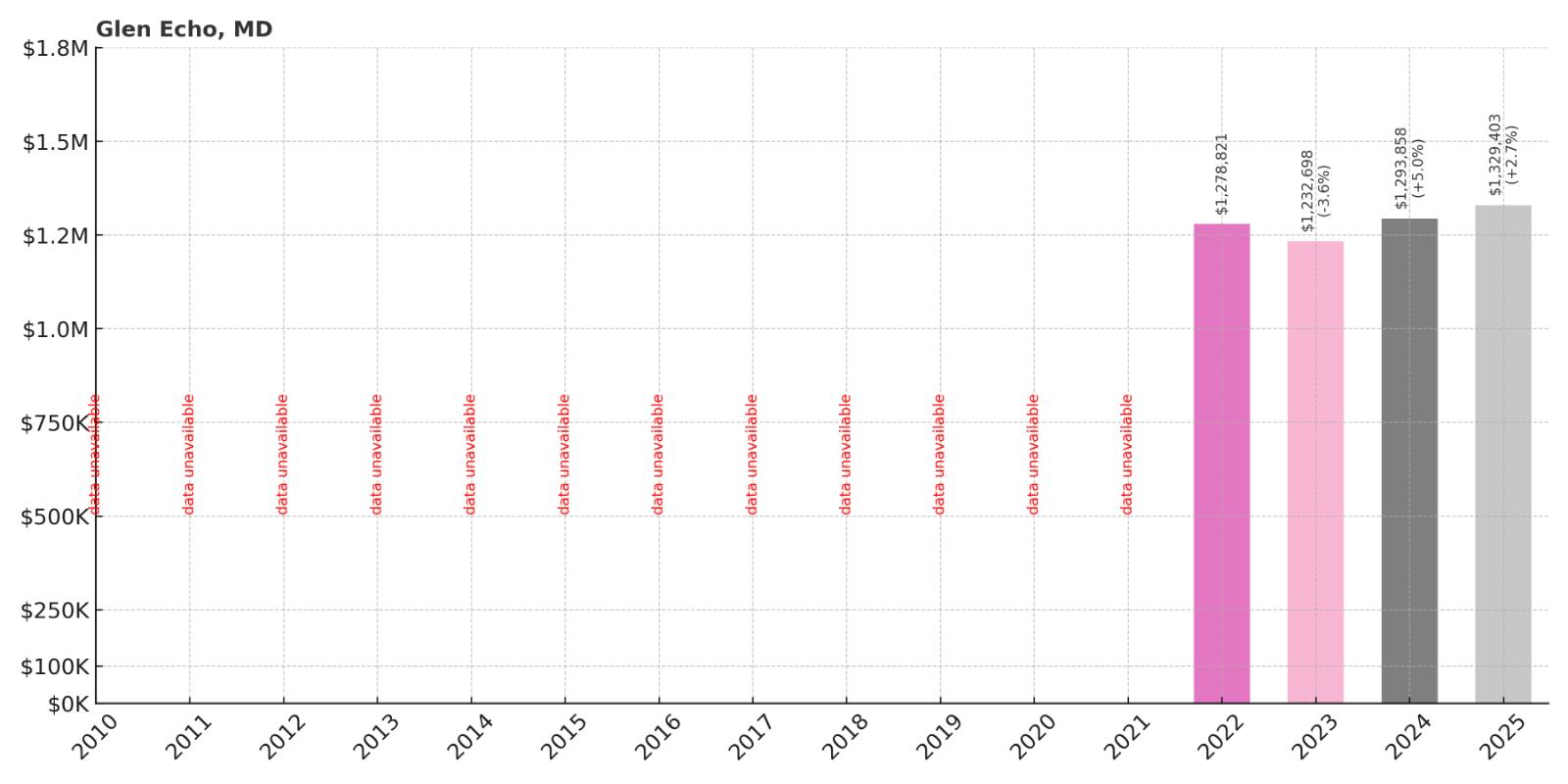
- 2010: N/A
- 2011: N/A
- 2012: N/A
- 2013: N/A
- 2014: N/A
- 2015: N/A
- 2016: N/A
- 2017: N/A
- 2018: N/A
- 2019: N/A
- 2020: N/A
- 2021: N/A
- 2022: $1,278,821
- 2023: $1,232,698
- 2024: $1,293,858
- 2025: $1,329,403
Glen Echo shows limited data beginning in 2022 at $1,278,821, with a dip in 2023 before recovering to over $1.32 million in 2025. The modest 4% increase since 2022 reflects a mature luxury market with steady demand. The high baseline indicates Glen Echo’s established position among the region’s most exclusive communities.
Why Glen Echo?

Why are people willing to pay so much to live here? What’s special about it?
Glen Echo attracts buyers seeking unique historic character and artistic heritage near Washington D.C. The small community features Victorian-era homes, tree-lined streets, and proximity to Glen Echo Park’s cultural programs and Potomac River recreation. Residents value the bohemian atmosphere, walkability, and convenient access to urban amenities while maintaining small-town intimacy.
The area appeals to artists, professionals, and cultural enthusiasts who appreciate the community’s creative legacy and architectural charm. Limited housing inventory and historic preservation requirements support premium property values. The combination of cultural amenities, natural beauty, and Washington D.C. proximity creates sustained demand for available properties.
How Glen Echo Rose to Prominence
Established in 1891 as a Chautauqua community dedicated to education, culture, and intellectual development, Glen Echo was designed as a summer retreat for learning and recreation. The National Chautauqua of Glen Echo featured lectures, concerts, and educational programs that attracted prominent speakers and performers. The Spanish-style buildings and cultural focus created a unique identity distinct from typical suburban development.
After the Chautauqua era ended in 1906, Glen Echo evolved into an amusement park destination before transitioning to a residential community. The preservation of historic buildings and cultural character attracted artists, writers, and professionals seeking creative community near Washington D.C. The establishment of Glen Echo Park as a National Park Service site in 1971 preserved the area’s cultural heritage while supporting residential property values through protected green space and cultural programming.
3 Interesting Tidbits
- Chautauqua Legacy – Glen Echo was founded as a Chautauqua community for adult education and cultural enrichment, hosting famous speakers like John Philip Sousa and William Jennings Bryan.
- Clara Barton Home – The founder of the American Red Cross, Clara Barton, lived in Glen Echo and her home is now a National Historic Site open for tours.
- Dance Heritage – Glen Echo Park continues to host traditional folk and contra dances in the restored Bumper Car Pavilion, maintaining the community’s cultural traditions.
3. Potomac – 46% Home Price Increase Since 2010
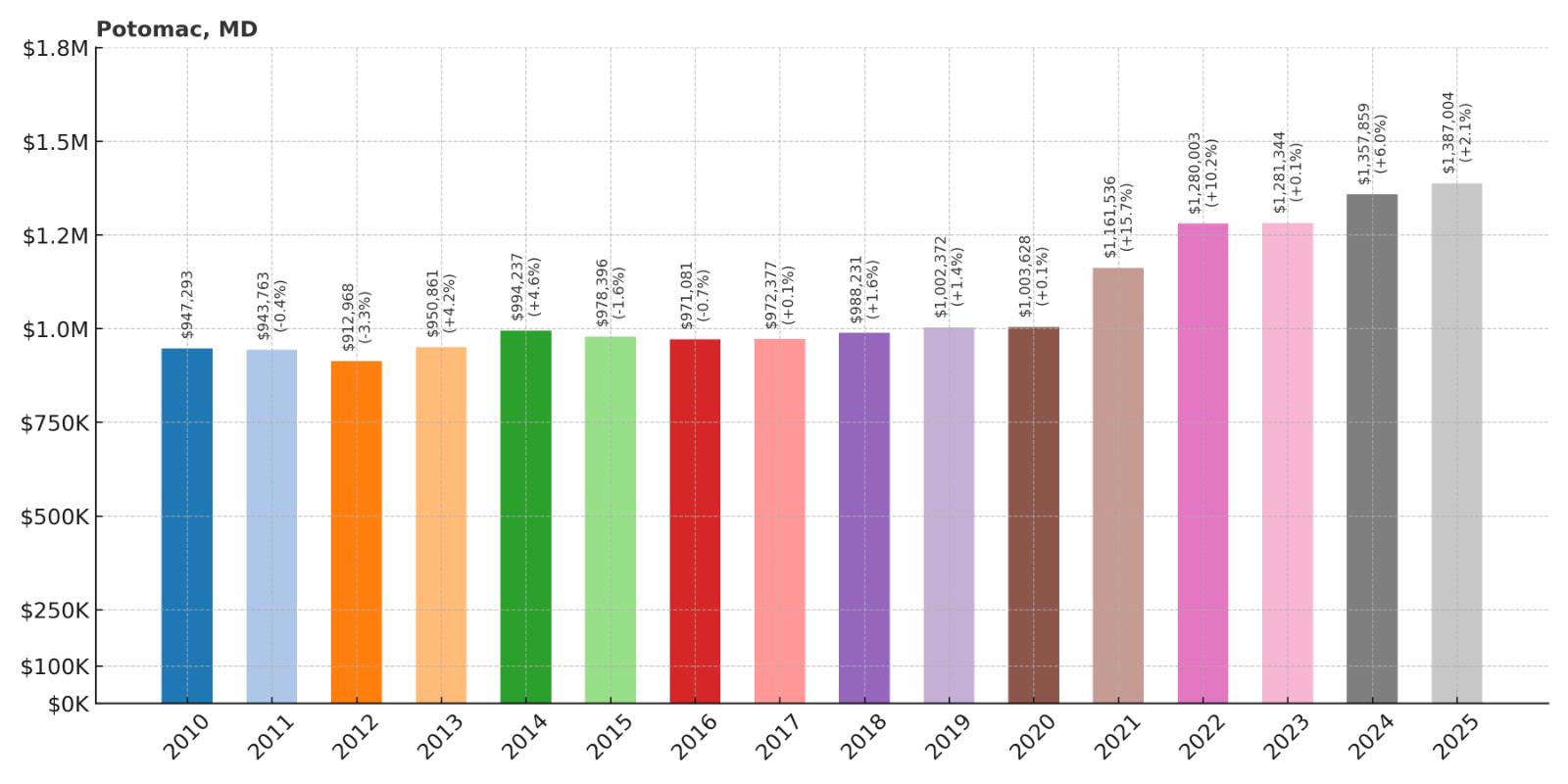
- 2010: $947,293
- 2011: $943,763
- 2012: $912,968
- 2013: $950,861
- 2014: $994,237
- 2015: $978,396
- 2016: $971,081
- 2017: $972,377
- 2018: $988,231
- 2019: $1,002,372
- 2020: $1,003,628
- 2021: $1,161,536
- 2022: $1,280,003
- 2023: $1,281,344
- 2024: $1,357,859
- 2025: $1,387,004
Starting from nearly $950,000 in 2010, Potomac showed steady appreciation with acceleration during 2021-2024. Values exceeded $1 million in 2019 and have continued climbing to nearly $1.39 million in 2025. The 46% increase reflects the community’s established status as one of the Washington metro area’s most prestigious addresses.
Why Potomac?
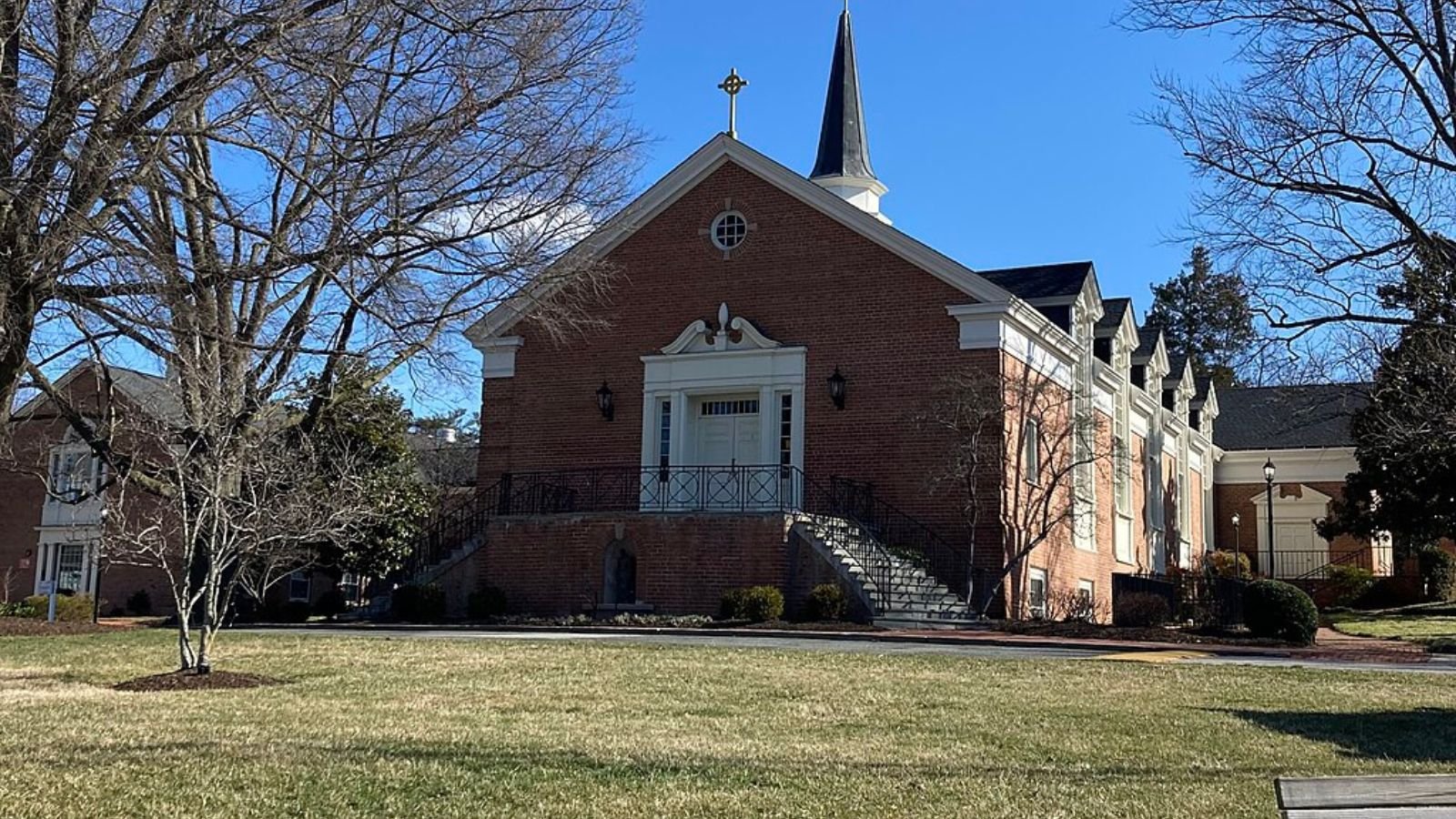
Why are people willing to pay so much to live here? What’s special about it?
Potomac attracts affluent families seeking grand estates and luxury properties with proximity to Washington D.C. The community features large lots, custom homes, and excellent Montgomery County schools while maintaining a country club atmosphere. Residents value the prestige, privacy, and access to recreational amenities including golf courses, riding trails, and parks.
The area appeals to successful professionals, government officials, and business leaders who want premium properties with space for entertaining and recreation. Strong zoning maintains large lot sizes and estate character while supporting multimillion-dollar property values. The combination of prestige, convenience, and recreational amenities creates sustained demand from affluent buyers.
How Potomac Rose to Prominence
Originally known as Offutt’s Crossroads after a local family, the community developed around the intersection of major roads connecting Washington D.C., Frederick, and the Potomac River crossings. The area remained largely agricultural through the early 20th century, with local farms supplying produce to Washington markets. The name was changed to Potomac in 1881 to reflect its proximity to the river.
The transformation to an exclusive suburban community began in the 1950s as Washington’s suburban growth reached Montgomery County. Large lot zoning and the development of country clubs attracted wealthy buyers seeking estate-style living with reasonable commuting access. The establishment of prestigious institutions and the influx of high-level government officials, diplomats, and business leaders cemented Potomac’s reputation as one of the region’s most exclusive addresses.
3 Interesting Tidbits
- Celebrity Haven – Potomac has been home to numerous politicians, diplomats, and celebrities, including multiple presidential cabinet members and Supreme Court justices.
- Country Club Culture – The community features multiple exclusive golf and country clubs, including Congressional Country Club, which has hosted major PGA tournaments.
- Mansion Showcase – Potomac regularly appears on lists of America’s most expensive zip codes, with many homes exceeding $2-3 million and some estates selling for over $10 million.
2. Chevy Chase View – 62% Home Price Increase Since 2010
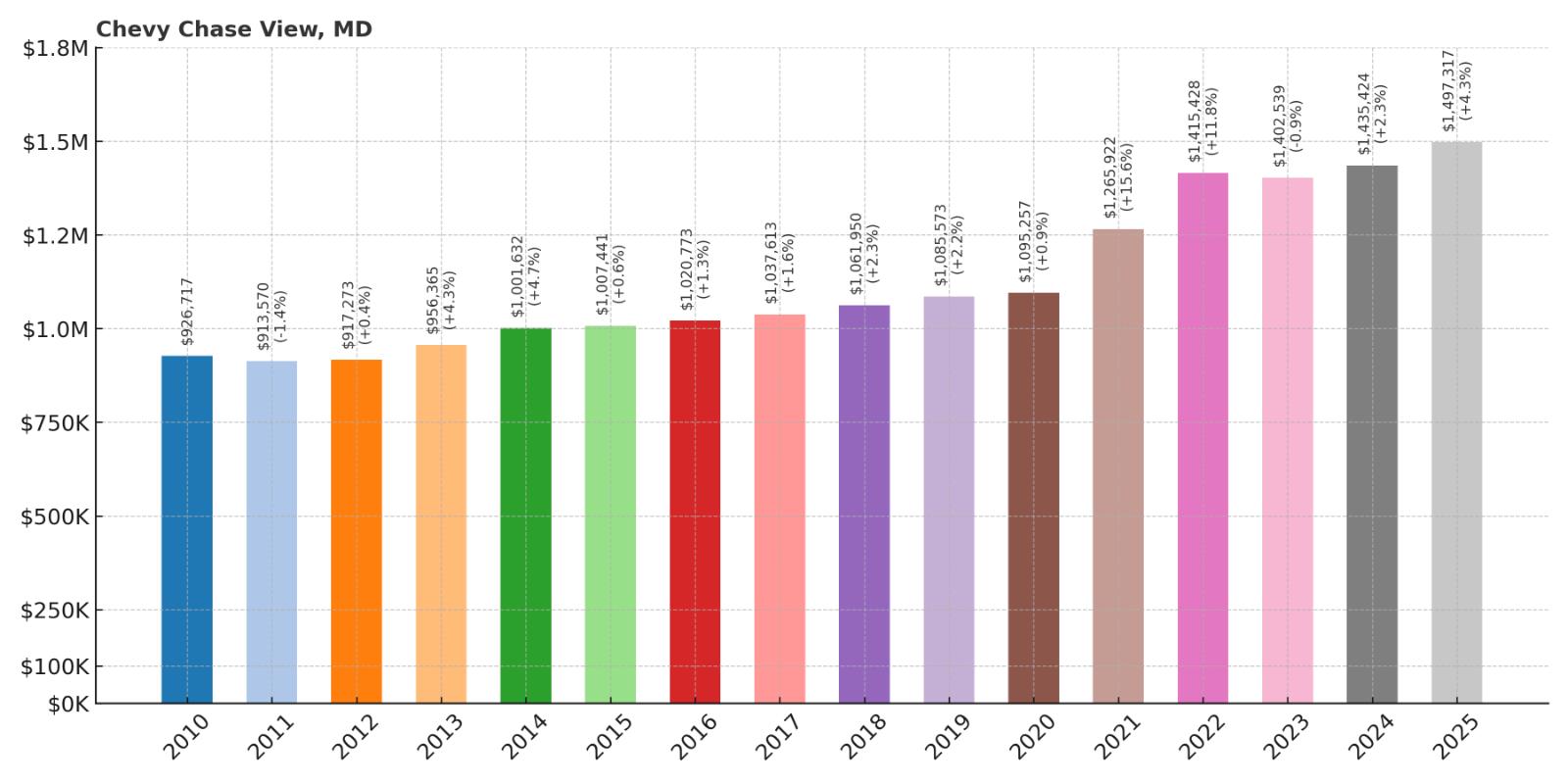
- 2010: $926,717
- 2011: $913,570
- 2012: $917,273
- 2013: $956,365
- 2014: $1,001,632
- 2015: $1,007,441
- 2016: $1,020,773
- 2017: $1,037,613
- 2018: $1,061,950
- 2019: $1,085,573
- 2020: $1,095,257
- 2021: $1,265,922
- 2022: $1,415,428
- 2023: $1,402,539
- 2024: $1,435,424
- 2025: $1,497,317
Starting from $926,717 in 2010, Chevy Chase View crossed the million-dollar threshold in 2014 and has continued steady appreciation to nearly $1.5 million in 2025. The 62% increase reflects the community’s evolution into one of the region’s most exclusive addresses, combining historic charm with prime Washington D.C. proximity.
Why Chevy Chase View?

Why are people willing to pay so much to live here? What’s special about it?
Chevy Chase View attracts the region’s elite seeking prestigious addresses with architectural distinction and Washington D.C. convenience. The community features grand homes on substantial lots with mature landscaping and exceptional privacy. Residents value the exclusive character, strong property appreciation, and proximity to diplomatic, political, and business centers.
The area appeals to high-level government officials, international business leaders, and diplomats who want the most prestigious residential addresses. Limited inventory and architectural quality support multimillion-dollar property values. The combination of exclusivity, convenience, and prestige creates intense competition for available properties among affluent buyers.
How Chevy Chase View Rose to Prominence
Developed as part of the broader Chevy Chase community in the early 1900s, Chevy Chase View was designed as one of the most exclusive sections with larger lots and more elaborate homes. The community attracted Washington’s social and political elite, including diplomats, cabinet members, and wealthy business leaders who wanted grand estates near the capital while maintaining suburban privacy.
Throughout the 20th century, Chevy Chase View maintained its reputation as one of the region’s most exclusive addresses through careful development control and architectural standards. The preservation of large lots, mature trees, and architectural quality has supported exceptional property values. The concentration of influential residents in government, diplomacy, and business has reinforced the community’s prestige and desirability among the nation’s elite.
3 Interesting Tidbits
- Diplomatic Quarter – Many foreign ambassadors and embassy officials maintain residences in Chevy Chase View, giving it an international character and diplomatic prestige.
- Political Powerhouse – The community has been home to numerous Supreme Court justices, cabinet secretaries, and other high-ranking government officials throughout its history.
- Architectural Showcase – Chevy Chase View features some of the region’s finest examples of early 20th-century residential architecture, including work by prominent architects of the Colonial Revival and Tudor styles.
1. Gibson Island – 82% Home Price Increase Since 2010
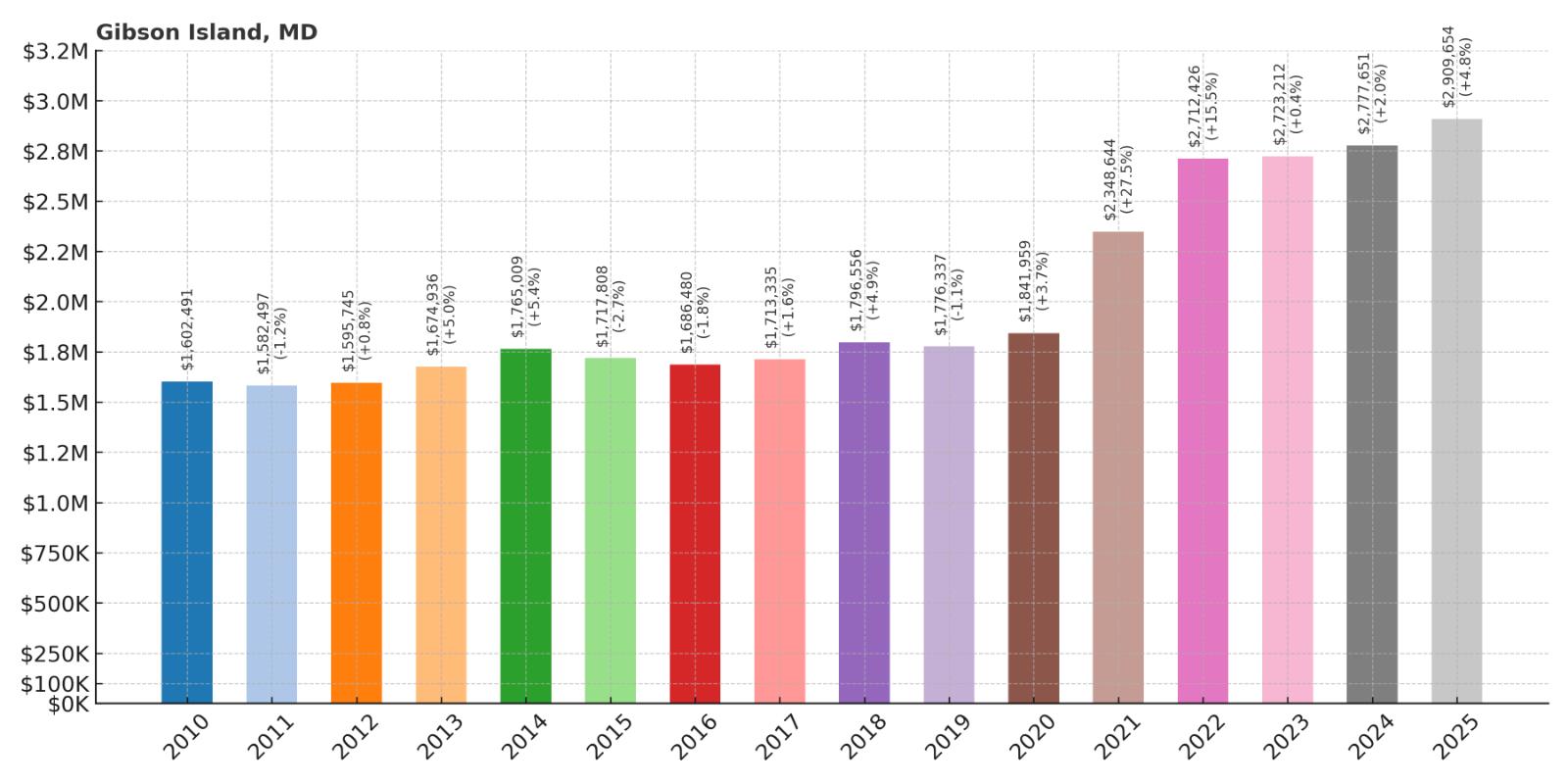
- 2010: $1,602,491
- 2011: $1,582,497
- 2012: $1,595,745
- 2013: $1,674,936
- 2014: $1,765,009
- 2015: $1,717,808
- 2016: $1,686,480
- 2017: $1,713,335
- 2018: $1,796,556
- 2019: $1,776,337
- 2020: $1,841,959
- 2021: $2,348,644
- 2022: $2,712,426
- 2023: $2,723,212
- 2024: $2,777,651
- 2025: $2,909,654
Gibson Island stands in a category by itself, with values starting at $1.6 million in 2010 and reaching nearly $2.91 million in 2025. The most dramatic growth occurred during 2021-2022, when prices jumped from $1.84 million to over $2.7 million. The 82% increase reflects the island’s unique position as Maryland’s most exclusive gated community.
Why Gibson Island?

Why are people willing to pay so much to live here? What’s special about it?
Gibson Island attracts ultra-affluent buyers seeking the ultimate in privacy, exclusivity, and waterfront luxury. This private 1,000-acre island community offers custom estates, private beaches, yacht club amenities, and golf course access available nowhere else in Maryland. Residents value the gated security, architectural heritage, and recreational opportunities that create a resort-like lifestyle year-round.
The community appeals to wealthy families seeking generational properties with unmatched privacy and prestige. Limited to approximately 200 homes with strict architectural controls and community governance, the island maintains exclusivity that supports multimillion-dollar valuations. The combination of Chesapeake Bay location, recreational amenities, and social prestige creates demand that far exceeds the limited housing supply.
How Gibson Island Rose to Prominence
Purchased in 1921 by Baltimore judge W. Stuart Symington Jr. for $165,000, Gibson Island was developed as an exclusive private summer community for prominent Baltimore and Washington families. The Olmsted Brothers landscape architecture firm designed the island’s layout to preserve natural beauty while providing lots for luxury homes. The original vision attracted wealthy businessmen, politicians, and socialites seeking refined country club living.
Throughout the 20th century, Gibson Island maintained its exclusive character through private ownership and strict membership requirements. The island community weathered economic downturns and social changes while preserving its status as one of America’s most exclusive addresses. Today, Gibson Island Corporation continues to control all aspects of island life, from property sales to recreational facilities, ensuring the community’s character and exclusivity that justify the premium pricing of available properties.
3 Interesting Tidbits
- Private Paradise – The entire 1,000-acre island is private property with 24-hour security, its own police force, and a causeway that can be restricted during private events.
- Golf Legacy – The nine-hole golf course was designed by Charles Blair Macdonald and Seth Raynor in the 1920s and is considered one of the finest short courses in America.
- Olmsted Design – The island’s layout was designed by the famous Olmsted Brothers landscape architecture firm, sons of Frederick Law Olmsted who designed Central Park.





